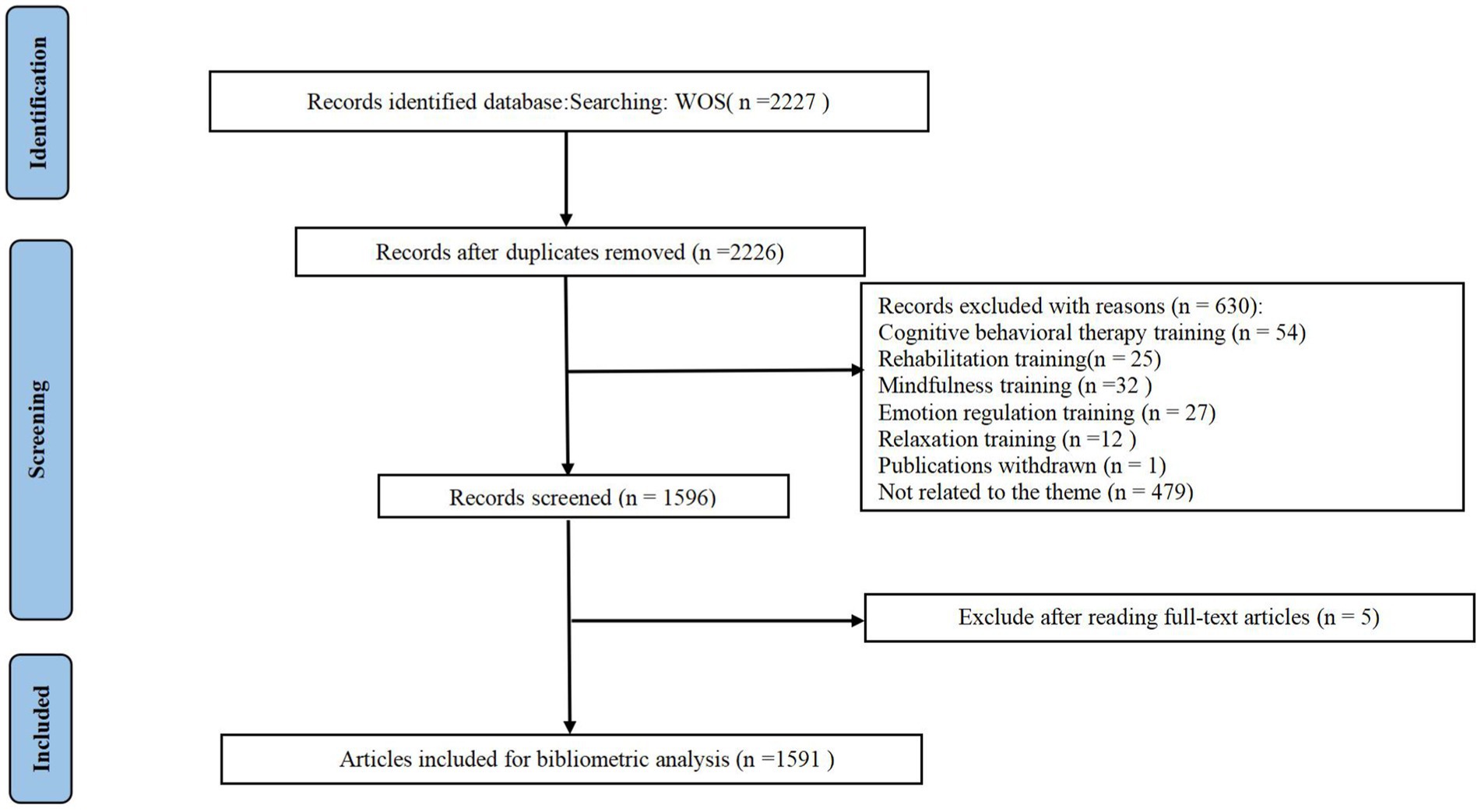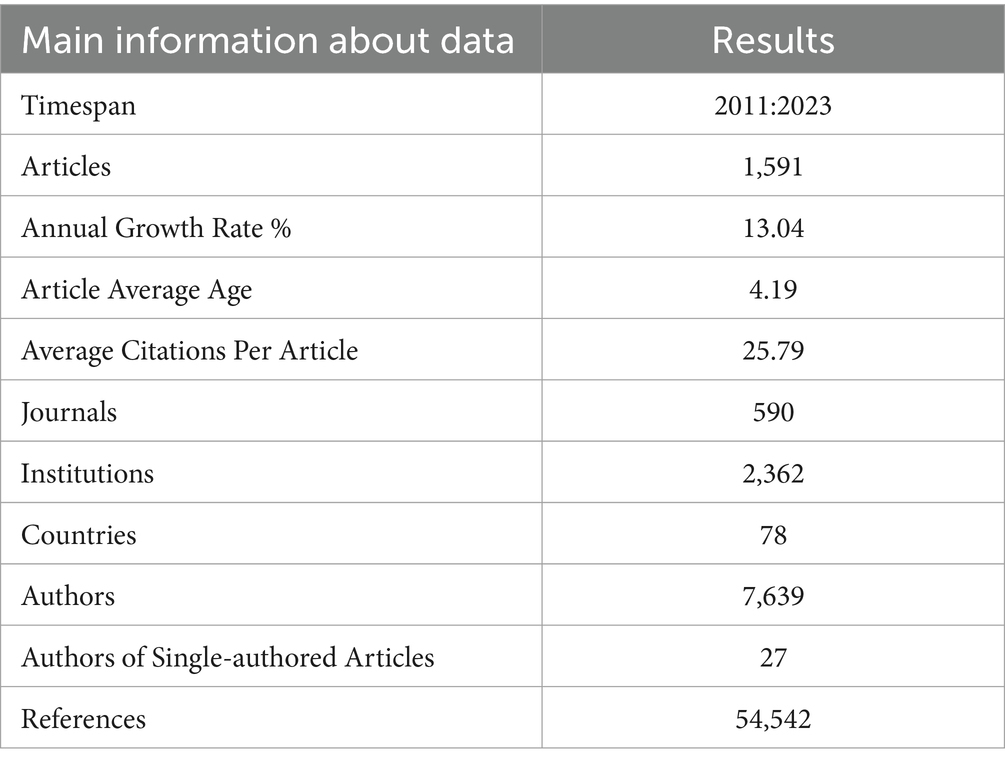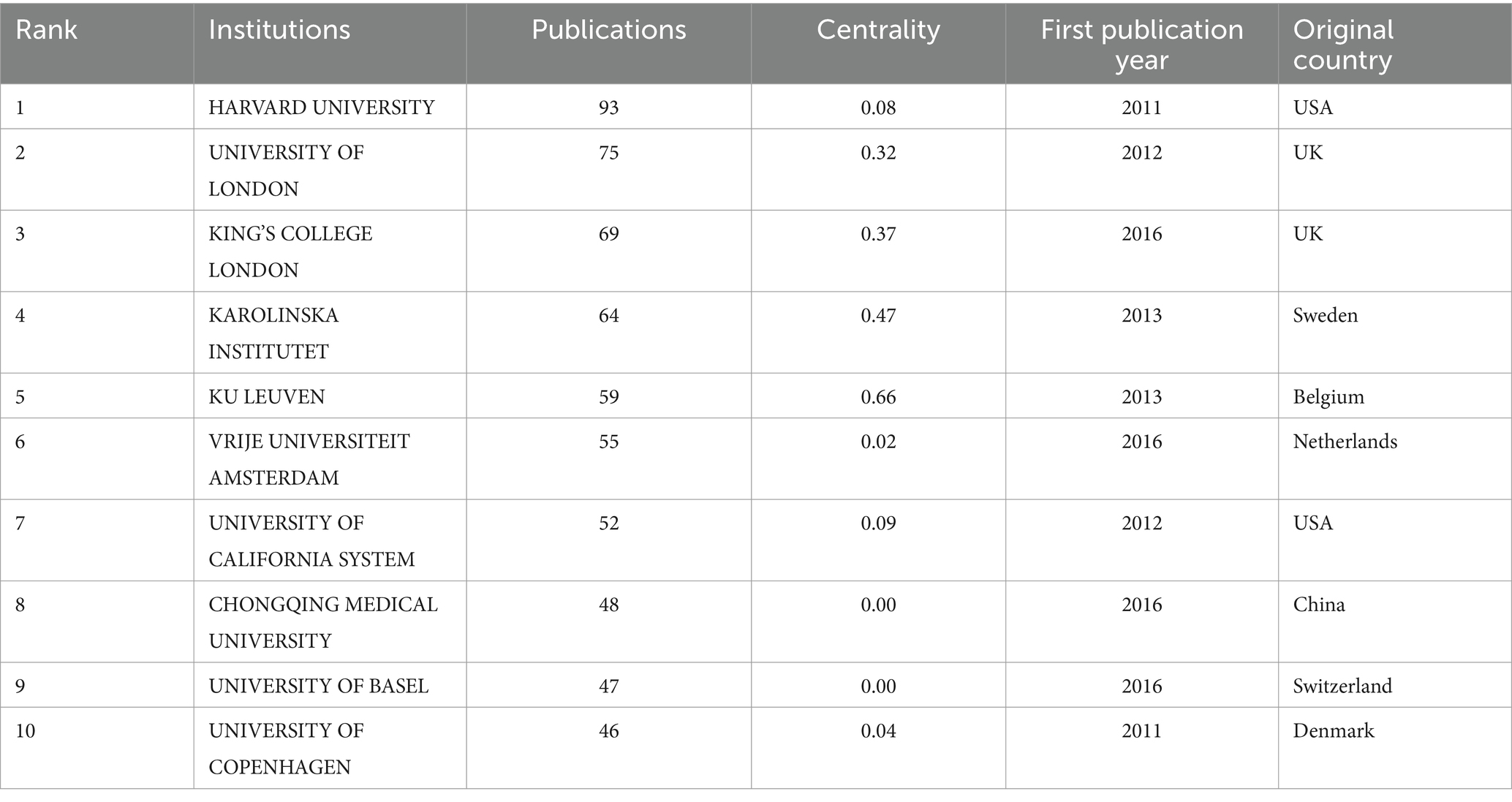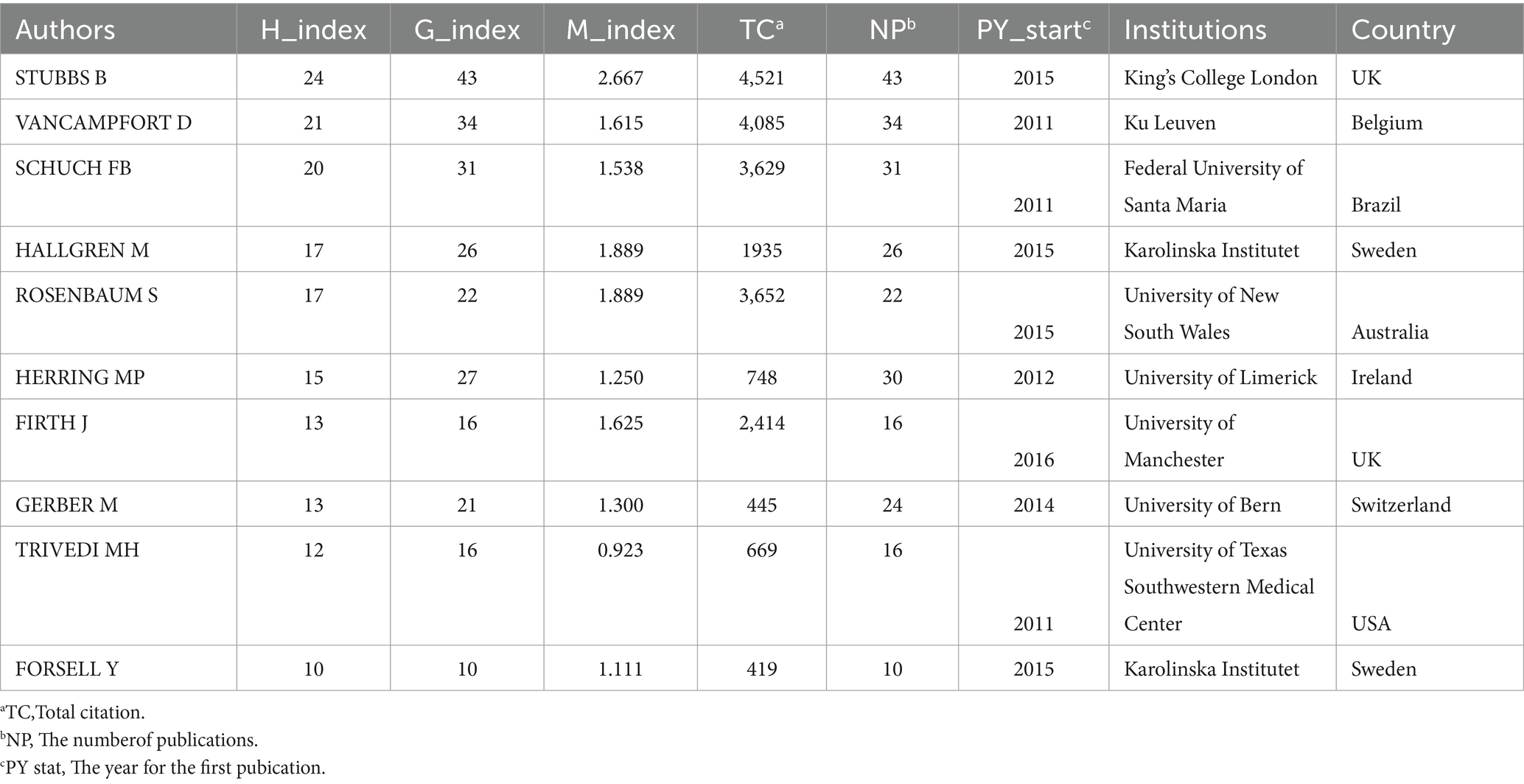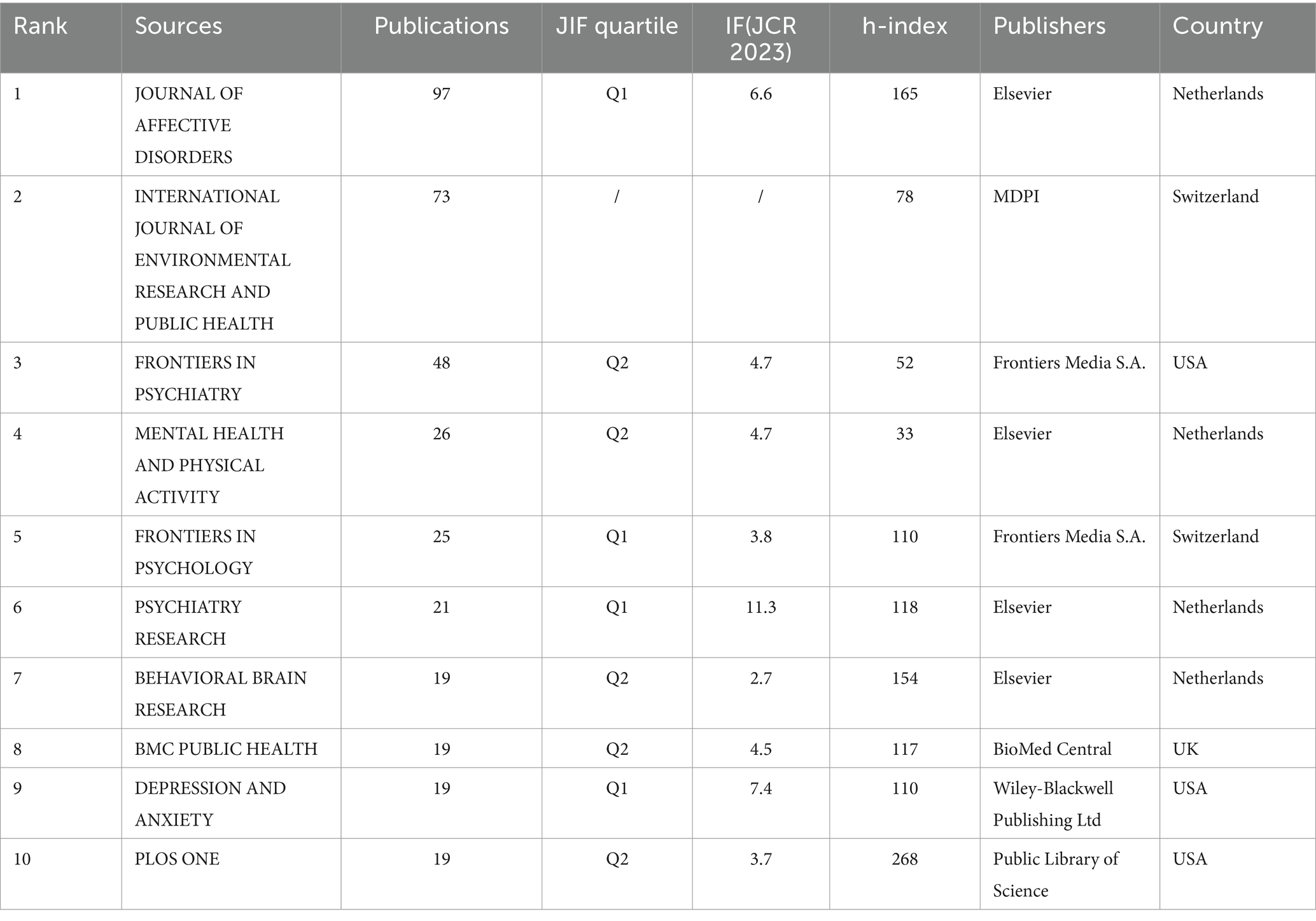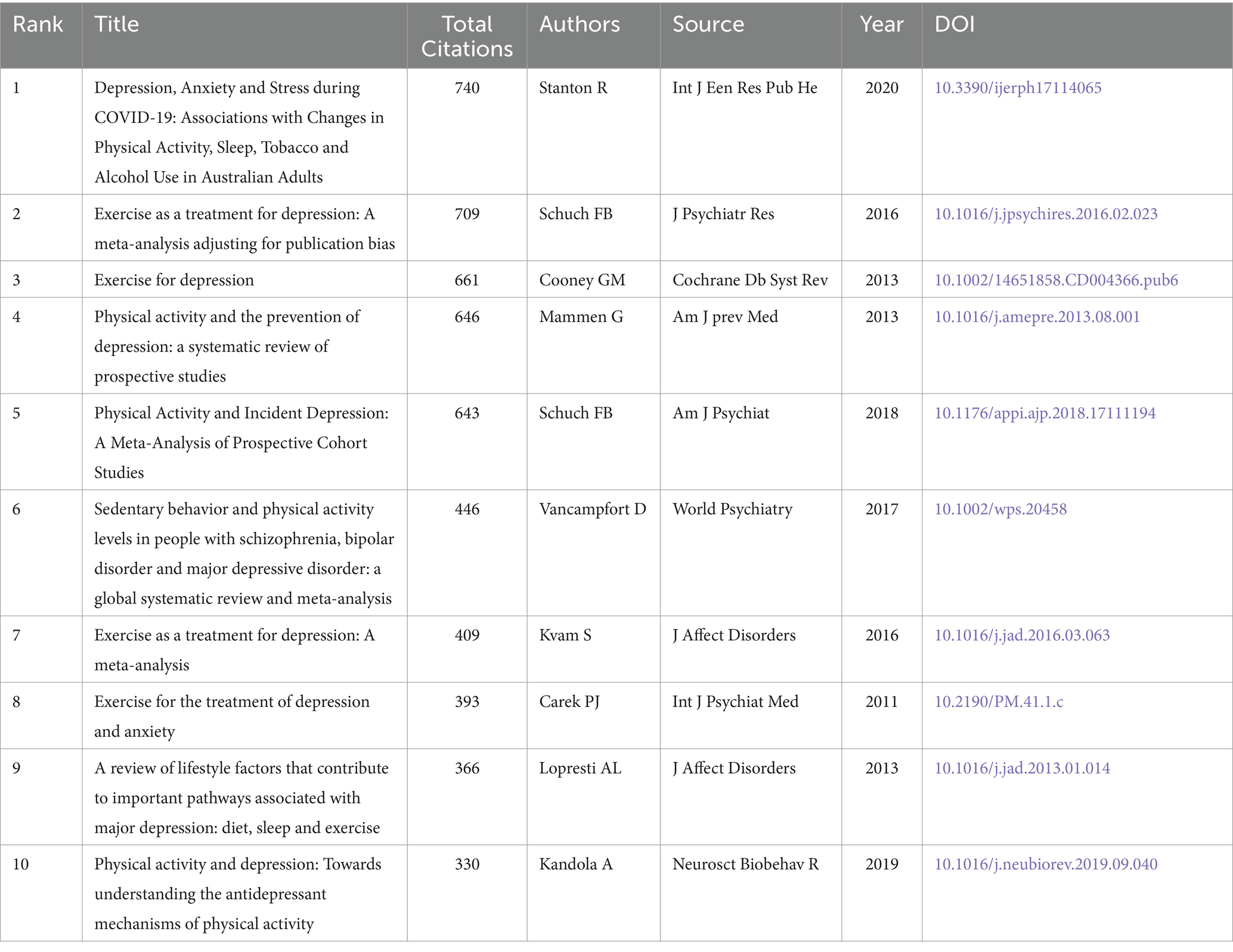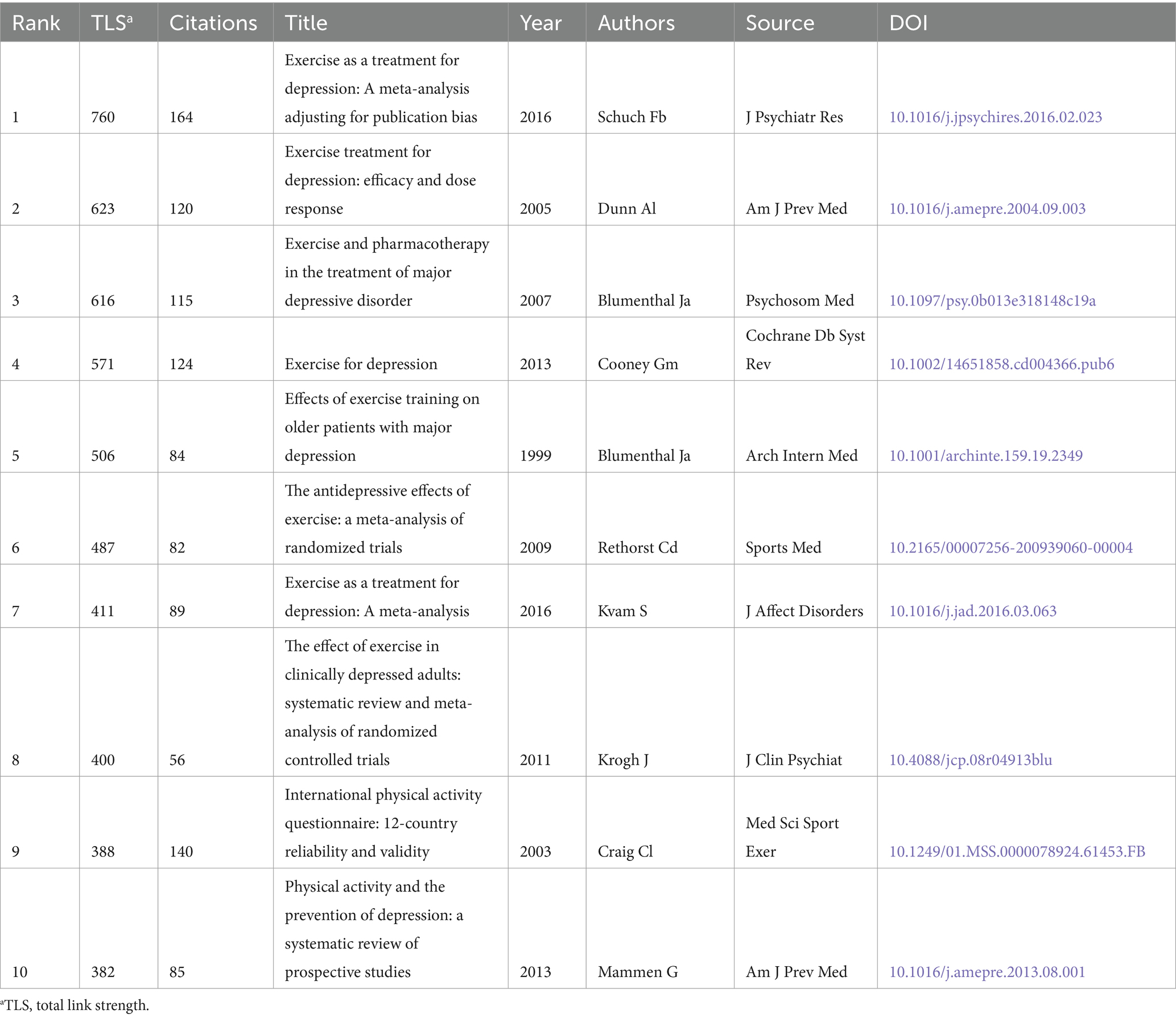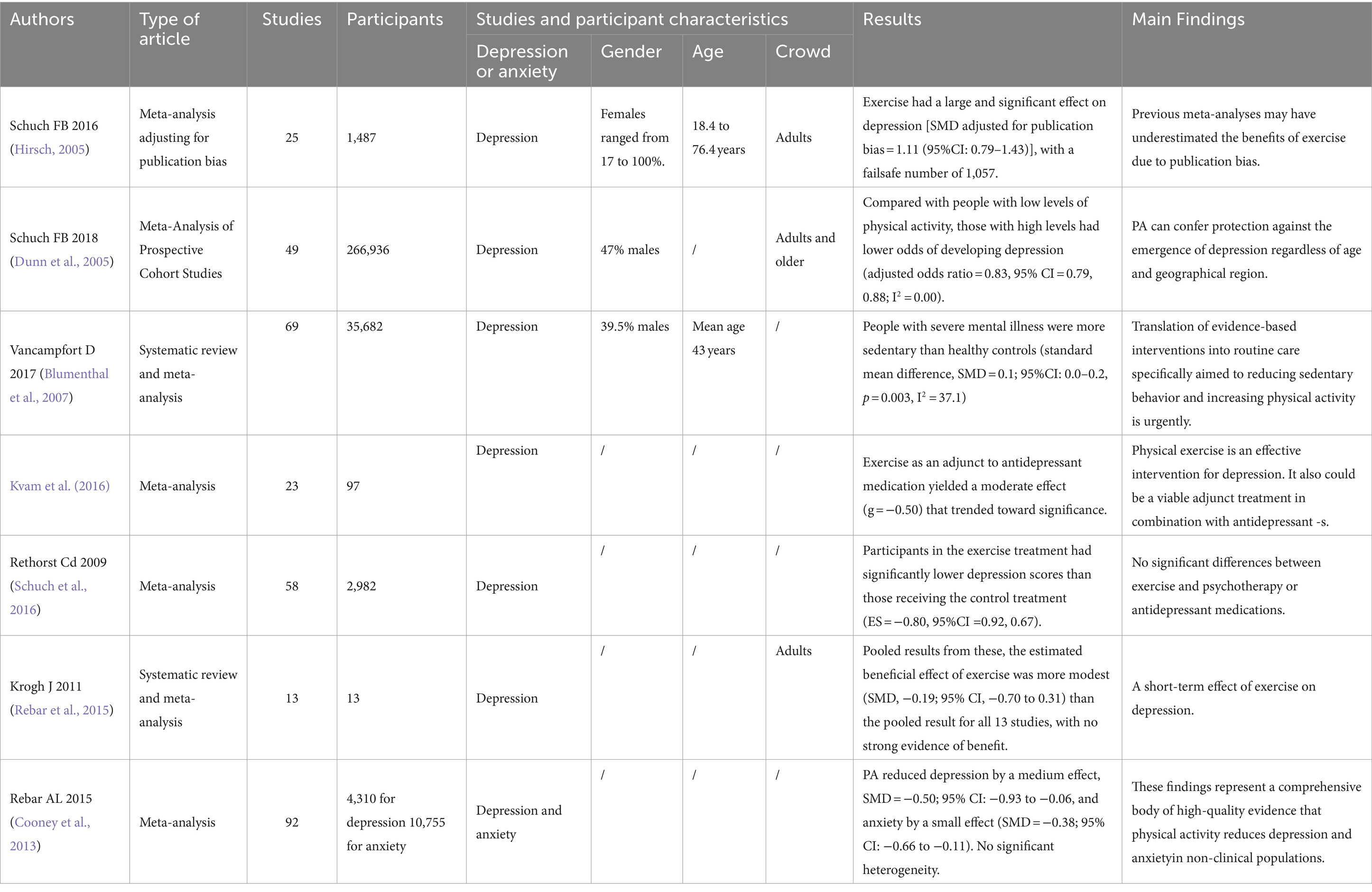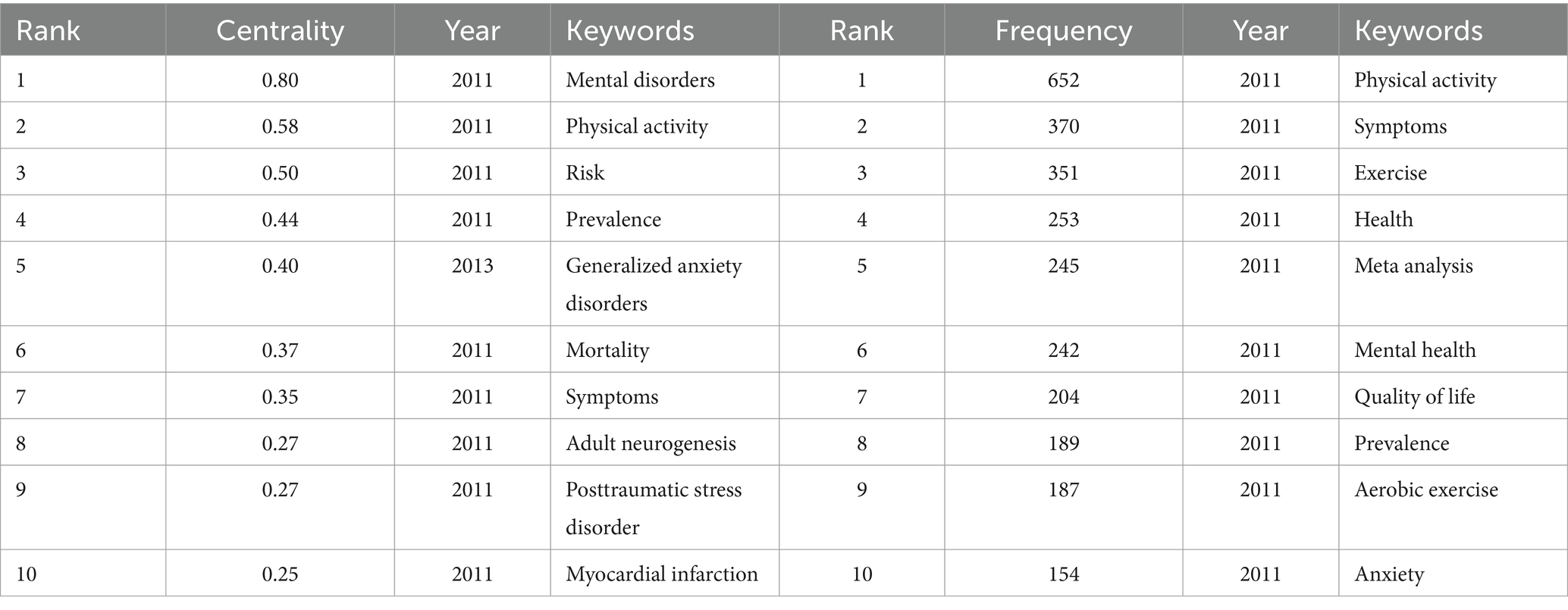- 1School of Acu-Mox and Tuina, Chengdu University of Traditional Chinese Medicine, Chengdu, Sichuan, China
- 2Acupuncture Clinical Research Center of Sichuan Province, Chengdu, China
- 3Department of Neurology, The Sichuan Province People's Hospital, Chengdu, China
Background: Anxiety and depression are prevalent mental disorders. As modern society continues to face mounting pressures, the incidence of anxiety and depression is on the rise. In recent years, there has been an increasing breadth of research exploring the relationship between anxiety, depression, and physical activity (PA). However, the current research progress and future development trends are unclear. The purpose of this study is to explore the research hotspots and development trends in this field, and to provide guidance for future studies and to provide some reference for clinicians.
Methods: We searched the relevant literature of Web of Science Core Collection from the establishment of the database to August 15, 2023. CiteSpace, VOSviewer and Bibliometrix Packages based on the R language were used to analyze the number of publications, countries, institutions, journals, authors, references, and keywords.
Results: A total of 1,591 studies were included in the analysis, and the research in the field of PA on anxiety or depression has consistently expanded. The USA (304 publications), Harvard University (93 publications), and the journal of affective disorders (97 publications) were the countries, institutions, and journals that published the highest number of articles, respectively. According to the keywords, students and pregnant women, adult neurogenesis, and Tai Chi were the groups of concern, physiological and pathological mechanisms, and the type of PA of interest, respectively.
Conclusion: The study of PA on anxiety or depression is experiencing ongoing expansion. Clinicians can consider advising patients to take mind–body exercise to improve mood. In addition, future researchers can explore the mind–body exercise and its impact on anxiety or depression, PA and anxiety or depression in specific populations, and adult neurogenesis of various exercise in anxiety or depression.
Introduction
Mental disorders have emerged as a significant public health issue, among which depression and anxiety are the most prevalent and one of the primary causes of the global health burden (Santomauro et al., 2021). Indeed, they severely impact mental health, social function activities and quality of life. Depression is typically characterized by persistent low mood, loss of interest, cognitive impairment, sleep disorders, loss of appetite and suicidal tendencies (McCarron et al., 2021). The World Health Organization (WHO) has listed depression as the third leading cause of the global burden of disease (Malhi and Mann, 2018). Moreover, the previous study (Slavich and Irwin, 2014) reported that nearly 25% of women and 16% of men will experience depression, and over 50% of patients with depression will relapse. Anxiety disorders are chiefly manifested as episodic or persistent anxiety, tension or panic and other emotions (Rezaei et al., 2023), accounting for approximately 3% of the global burden of disease (Madonna et al., 2019). In a systematic retrospective study of disease prevalence studies in 44 countries, the global prevalence of anxiety disorders was estimated at 7.3% (Baxter et al., 2013). With the increasing pressure of modern human society, the accelerated pace of life is accompanied by an increase in a variety of various stress factors, leading to an increase in the incidence of depression and anxiety disorders, becoming one of the world’s major concerns.
The pathogenesis of depression and anxiety disorders remains unclear despite considerable research in the field (Malhi and Mann, 2018) involving the regulation of multi-system dysfunction. Through extensive clinical and animal experiments, genetics, biology, and social psychology have been established to participate in the development of diseases (Guilloux et al., 2011; Beesdo-Baum and Knappe, 2012; Fischer et al., 2018; Malhi and Mann, 2018). Drug therapy is a common clinical approach but is associated with side effects. Antidepressants have potential adverse reactions such as gastrointestinal symptoms, respiratory distress, hepatotoxicity, and allergic reactions (Carvalho et al., 2016). On the other hand, anxiolytics can lead to addiction (Offidani et al., 2013), gastrointestinal disorders (Harvey et al., 2000), and sexual dysfunction (Clayton et al., 2002). However, physical activity (PA) is considered a critical health behavior. The term “physical activity intervention” captures a broad range of interventions aimed at increasing energy expenditure above resting levels (Caspersen et al., 1985), encompassing aerobic exercise, resistance exercise, weight training, dance, yoga, tai chi, wuqinxi, baduanjin, and yijinjing (Noone et al., 2018).
In the previous studies, researchers focused on the health benefits of PA and revealed that exercise can mitigate the risk of diseases such as cardiovascular disease (Valenzuela et al., 2023), obesity (Hao et al., 2023) and diabetes (Kazeminasab et al., 2023). Afterward, studies have shifted toward the relationship between exercise and mental health. The 2018 American Sports Guide Advisory Committee report highlighted that PA can alleviate anxiety and depression symptoms (Pate, 2019). Previous evidence-based studies have also established that PA is an effective, safe, low-cost, and convenient method for the treatment of depression and anxiety (Mammen and Faulkner, 2013; Singh et al., 2023). Likewise, Singh et al. (2023) demonstrated that physical activity can significantly relieve symptoms of depression, anxiety and distress across a wide range of adult populations. Kvam et al. (2016) found that physical exercise is an effective intervention for depression. However, the current research progress and future development trends are unclear, impeding further exploration and development of PA interventions for anxiety and depression.
Bibliometrics is a research method commonly adopted to analyze scientific literature and identify research hotspots and emerging trends (Chen et al., 2012). The advantage of bibliometrics analysis lies in the wide range of included studies. Through the intuitive visual display of bibliometrics, the development of a specific field can be more intuitively, comprehensively, and systematically elucidated. Consequently, this research method has been widely applied across various fields (Chen et al., 2012; Dong et al., 2021; Cui et al., 2023). In the previous searches, relevant bibliometrics analysis were identified but were limited in terms of time (You et al., 2021), population (Ai et al., 2023) and disease type (Zhai and Xu, 2023). To the best of our knowledge, there is no comprehensive bibliometric analysis addressing on the current status and trends of PA on anxiety and depression. Therefore, the objective of this study is to present the current research status, hotspots, and trends of PA on anxiety and depression, and to lay a theoretical reference for subsequent research directions and to help clinicians better carry out clinical work.
Methods
To date, there are no standardized guidelines for bibliometric analysis. Nevertheless, this study was conducted in accordance with the recommendations of the Preferred Reporting Items for Systematic Reviews and Meta-Analyses 2020 (Page et al., 2021) (PRISMA 2020) (Appendix 1). Additionally, this study was registered on the Open Science Framework (OSF) with the registration DOI: https://doi.org/10.17605/OSF.IO/7NJUP.Registration after data analysis was selected based on specific circumstances.
Data collection and search strategies
In this study, the relevant literatures of Web of Science Core Collection (WoSCC) from the establishment of the database to August 15, 2023 were searched. Because we only focus on research trends and hotspots, based on previous bibliometric studies (Xiong et al., 2021; Mendlowicz et al., 2022; Yang et al., 2022; Ji et al., 2023), articles were screened by title rather than topic in order to avoid the influence of confounding factors in the abstract. The WoSCC search formula was set as follows: TI = [(‘depressive disorder’ OR ‘depression’ OR ‘anxiety’) AND (‘exercise’ OR ‘training’ OR ‘dance’ OR ‘aerobic’ OR ‘fitness’ OR ‘cardio ‘OR ‘physical activity’ OR ‘resistance exercise’ OR ‘weight training’ OR ‘yoga’ OR ‘taichi’ OR ‘wuqinxi’ OR ‘baduanjin’ OR ‘yijinjing’)]. The article retrieval and data extraction were completed within 1 day on August 15, 2023, to avoid potential biases caused by daily database updates.
Two independent reviewers (X-YZ and Y-QL) screened titles, keywords, and abstracts for relevance. Duplicate and ineligible studies were excluded. All remaining studies were examined for inclusion once the full text had been reviewed. In case of disagreements, a third reviewer (F-RL) counterchecked and arbitrated. The detailed retrieval process was shown in Figure 1.
Inclusion/ exclusion criteria
Inclusion criteria were: (1) Peer-reviewed published articles on physical activity and anxiety or depression, including basic and clinical research; (2) Physical activities include aerobic exercise, resistance exercise, weight training, dance, yoga, tai chi, wuqinxi, baduanjin, and yijinjing; (3) The main types of literatures chosen for our study were articles and reviews; (4) The language of the article is limited to English.
Exclusion criteria were: (1) The articles unrelated to the research theme; (2) Articles not officially published; (3) Conference abstracts and proceedings and corrigendum documents; (4) Articles not in English language.
Statistical analysis and tools
In this study, CiteSpace (version 6.2.4), VOSviewer (version 1.6.19), and Bibliometrix Packages based on the R language (version 4.3.1) were used to perform this bibliometric analysis.
CiteSpace is mainly used to count centrality and generate cooperation network visualizations. It can reveal changes in emerging trends, identify research frontiers (Chen et al., 2012). The visualization map consists of nodes and lines, where the size of the nodes is determined by the number of items (Chen and Song, 2019), and the connections between the nodes reveal collaboration or references. The betweenness centrality measure quantifies the importance and connectivity of the node’s location in the network. The higher the betweenness centrality is, the more the related connections are (Zhu et al., 2022). The basic parameters were as follows: time slicing (2011–2023), years per slice (5), top N per slice (12), pruning (pathfinder, pruning sliced networks and pruning the merged network).
Vosviewer is an analysis software based on network data to construct a visual network map (van Eck and Waltman, 2010), which can systematically understand the structure and dynamic development of scientific research. In Vosviewer’s cooperation network visualizations map and co-citation network visualizations map, different colors represent different clusters, and the lines between circles represent the cooperative relationship between different points. In this study, VOSviewer 1.6.18 was used to visualize the authors and references based on data.
The bibliometrix is an online visualization package based on R studio. Literature analysis statistics, index calculation, network analysis and knowledge map drawing can be carried out. The detailed method is shown in Figure 2A.
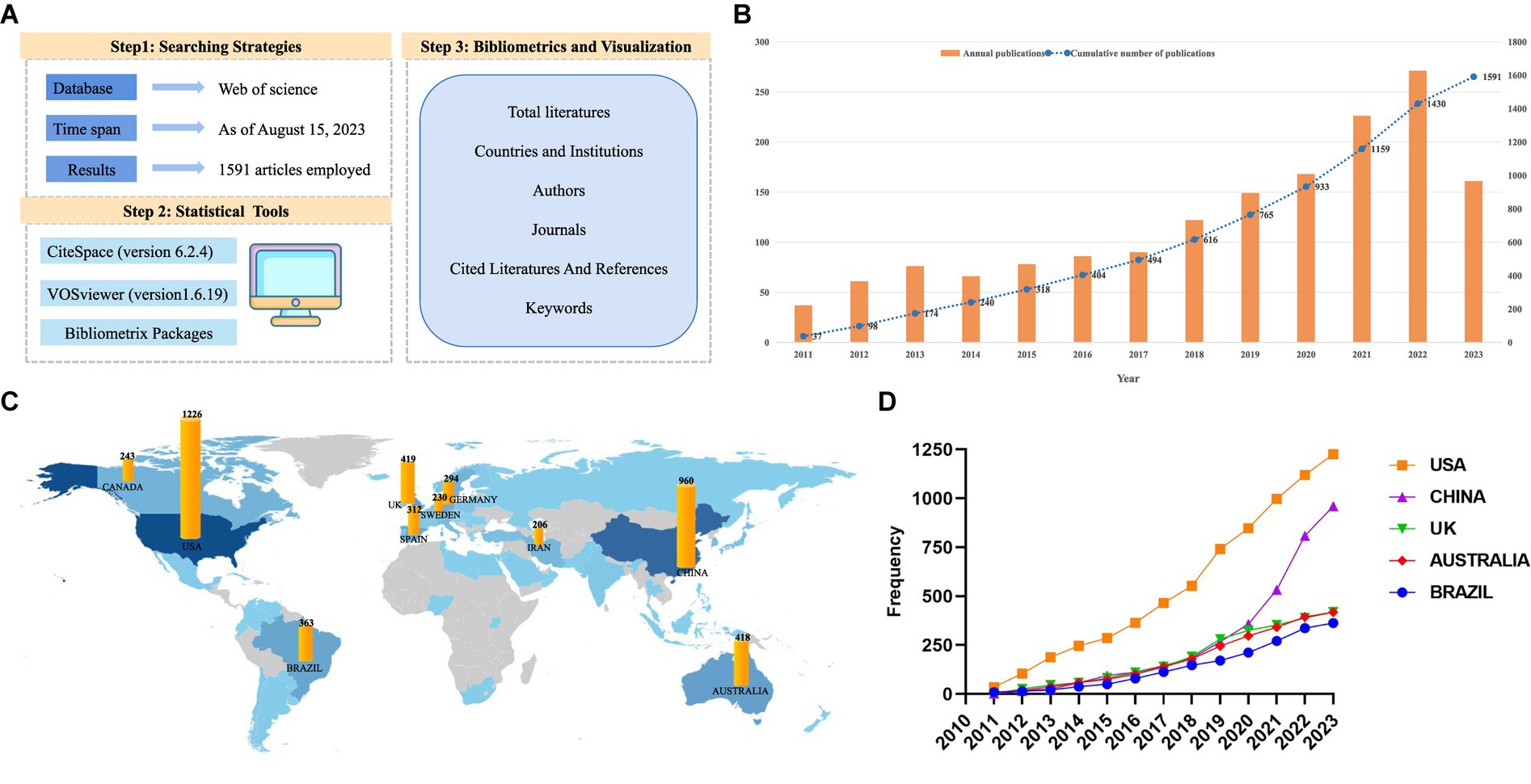
Figure 2. (A) The detailed method. (B) The number of articles published and the annual cumulative number of publications in each year about PA on depression or anxiety. (C) The top 10 countries by publication frequency. (D) The annual publication frequency line chart of the top 5 countries.
Results
Literature screening results
According to the literature search strategy, a total of 2,227 articles were retrieved. To read the titles, abstracts, and even the full texts of paper to filter out papers that are closely related to our subject. Only 1,591 publications were enrolled. The main information of the included studies is shown in Table 1.
Publication growth and outputs
The change in the number of papers published annually is an important indicator, and the number of articles published during each period provides an intuitive indication of research trends in this field. According to our search strategy, the publication time of the 1,591 articles included was statistically analyzed, exposing that the number of related articles progressively increased over time (Figure 2B). Given that the retrieval time extended up to August 15,2023, the number of publications in 2023 currently appeared to be lower than that in 2022. However, the annual cumulative number of publications exhibited a consistent upward trend. According to the growth curve of the number of published papers, we postulate that the impact of PA on anxiety or depression is garnering increasing attention.
Analysis of countries and institutions
A total of 78 countries participated in studies investigating the effect of PA on depression or anxiety. According to Table 2, the USA (1,226 times) was the leading country in terms of related publications, followed by China (960 times) and the UK (419 times) (Figure 2C). As illustrated in Figure 2D, the frequency of studies published in the United States and China has significantly increased on a yearly basis. Moreover, according to the national statistics of the corresponding author in the article, the USA emerged as leading country (304 publications), followed by China (280 publications) and Brazil (87 publications). The multiple country publications ratio refers to the proportion of co-authored articles in a country’s published articles. A larger value reflects a higher number of articles and a higher degree of cooperation with other countries. Interestingly, the MCP ratio value of Brazil was the largest (0.448), indicating that the country extensively cooperated with other countries. In addition, Brazil and Sweden had the highest centrality (over 0.1), implying that these two countries are the primary research centers in the field of the role of PA on depression or anxiety.
A total of 2,362 institutions published articles of PA on depression or anxiety. As summarized in Table 3, among the top ten institutions, two institutions were from the USA and the UK, respectively. Notably, the top three high-yield institutions in this field were HARVARD UNIVERSITY (93 publications), UNIVERSITY OF LONDON (75 publications) and KING ‘S COLLEGE LONDON (69 publications). While the publication volume of KU LEUVEN was not the highest, its centrality was the highest (0.66), indicating that the organization plays an important role in the field. In addition, the centrality of UNIVERSITY OF LONDON (0.32), KING ‘S COLLEGE LONDON (0.37), and KAROLINSKA INSTITUTET (0.47) was also greater than 0.1, signifying that they also had a strong academic influence in this field. From the aforementioned results, it can be deduced that in the field of PA with depression or anxiety, despite the USA and China having published a large number of papers, their influence and cooperation with other countries remain sub-optimal.
Analysis of authors
According to the results, a total of 7,639 authors published articles of PA on depression or anxiety. As detailed in Table 4, the top three authors in terms of the H-index were Stubbs B (24), Vancampfort D (21), and Schuch FB (20), with these authors also leading in total citations. Besides, the number of publications of these three authors was 43, 34, and 31, respectively. The H-index is a standardized indicator that reflects the number and impact of publications at the individual level (Hirsch, 2005; Hirsch, 2007). Of note, the g-index and m-index were derived from the h-index (Ali, 2021). These three indexes can collectively reflect the individual’s academic influence. As displayed in Figures 3A–D, Stubbs B, from the King’s College London in the UK, was the most prominent author, ranking first in all three indices. Although Stubbs B’s study of PA on depression or anxiety was initiated in 2015, it ranked first in terms of total citations. According to the ranking of the H-index, two of the top ten authors originated from the UK, demonstrating that the influence of the UK in this field should not be underestimated. According to the author’s network visualization (Figure 3E) and density visualization (Figure 3F), a cooperative network centered on Stubbs B and Gerber M was formed, wherein the former had more and closer cooperation. However, cooperation between the two authors is still lacking.
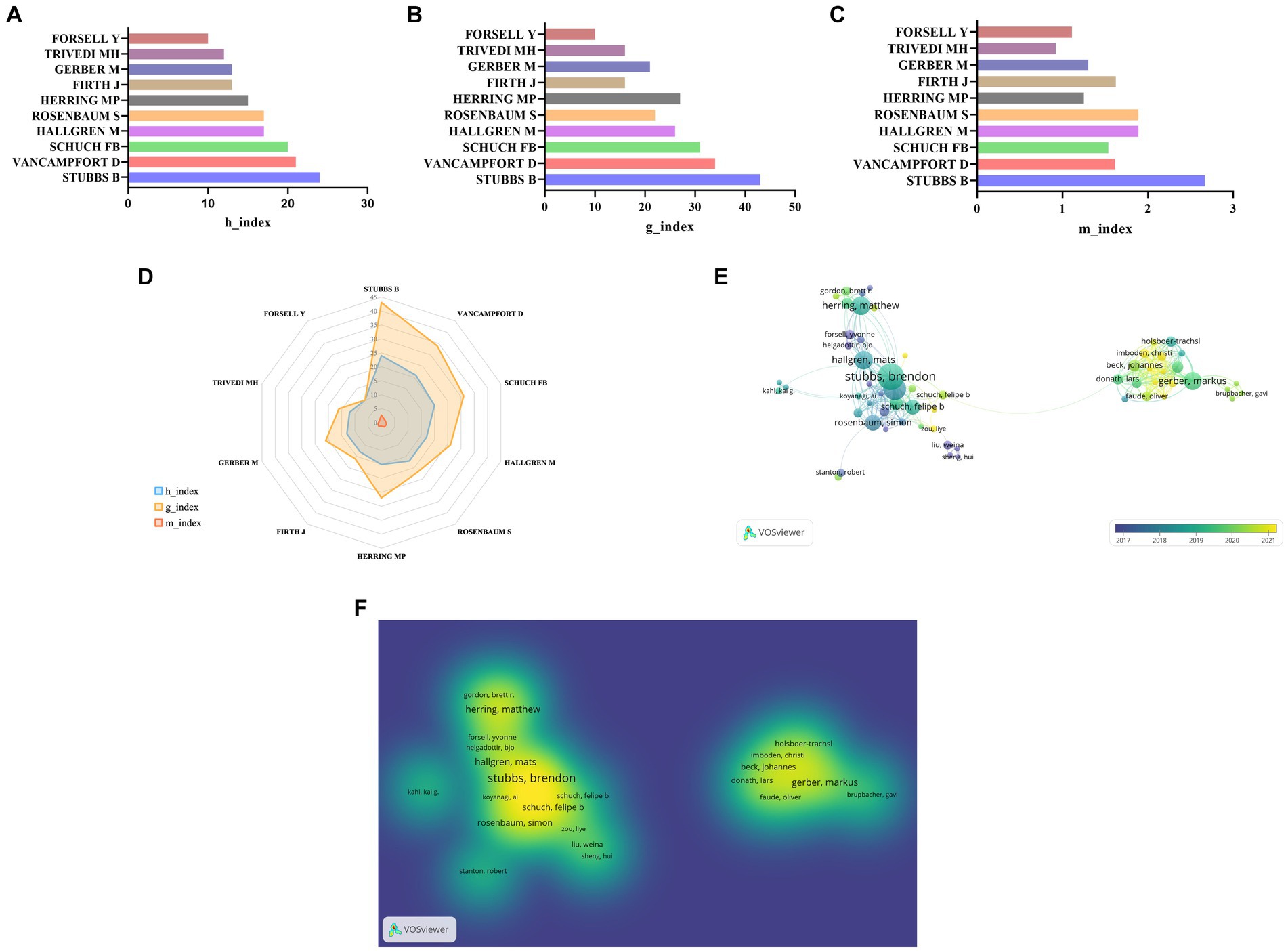
Figure 3. (A) Top 10 authors in terms of h-index. (B) Top 10 authors in terms of g-index. (C) Top 10 authors in terms of m-index. (D) The radar map of the top 10 authors in terms of h-index, g-index and m-index. (E) The author’s network visualization. (F) The author’s density visualization.
Analysis of journals
A total of 590 journals published relevant articles of PA on depression or anxiety. According to the number of publications (Table 5), the top three magazines are JOURNAL OF AFFECTIVE DISORDERS (97 publication), INTERNATIONAL JOURNAL OF ENVIRONMENTAL RESEARCH AND PUBLIC HEALTH (73 publication), and FRONTIERS IN PSYCHIATRY (48 publication) respectively. The top 10 most productive journals in Table 4 are mainly in Q1 or Q2. The top three journals of H-index in this field are PLOS ONE (268, IF3.7), JOURNAL OF AFFECTIVE DISORDERS (165, IF6.6), and BEHAVIORAL BRAIN RESEARCH (154, IF11.3).
Analysis of cited literatures and references
The top ten highly cited articles in the field of PA on depression or anxiety based on total citations are listed in Table 6. The top three were articles published by Stanton R in 2020 (Stanton et al., 2020) (740 citations), followed by articles published by Schuch et al. (2016) (709 citations), titled “Exercise as a treatment for depression: A meta-analysis adjusting for publication bias,” and Cooney GM in 2013 (Cooney et al., 2013) (661 citations), titled “Exercise for depression.” Despite the article published by Stanton R in 2020 (Stanton et al., 2020) being the most recent one, it garnered the highest number of citations. This observation may be attributed to the increased attention paid to the novel coronavirus in recent years. This paper (Stanton et al., 2020) largely examined the relationship between depression, anxiety and physical activity of adults during the COVID-19 pandemic.
The final analysis results involved a total of 54,542 references. As portrayed in Table 7, based on the strength of the total link strength (TSL), the top three were those published by Schuch et al. (2016) (TLS 760), Dunn Al in 2005 (Dunn et al., 2005) (TLS 623), and Blumenthal Ja in 2007 (Blumenthal et al., 2007) (TLS 616). They were related to exercise and depression. Research with a larger number of citations holds considerable implications in this field and offers a theoretical foundation for subsequent research by others. Using Vosviewer, the minimum number of citations of cited references was 40, and the cited references network visualization (Figure 4A) and density visualization were generated (Figure 4B). As delineated in visualization map, the three clusters are closely related. Cluster 1was based on Schuch Fb’s article published in 2016 (Schuch et al., 2016) (TLS 760), cluster 2 was based on Dunn Al ‘s article published in 2005 (Dunn et al., 2005) (TLS 623), whilst cluster 3 was based on Rebar AL’s article published in 2015 (Rebar et al., 2015) (TLS 267). We further analyzed the meta-analysis studies in cited literatures and references (Table 8). However, from these eight meta-analyses (Rethorst et al., 2009; Krogh et al., 2011; Rebar et al., 2015; Kvam et al., 2016; Schuch et al., 2016; Vancampfort et al., 2017; Schuch et al., 2018), the impact of gender, age, population, and other factors on the results could not be determined.
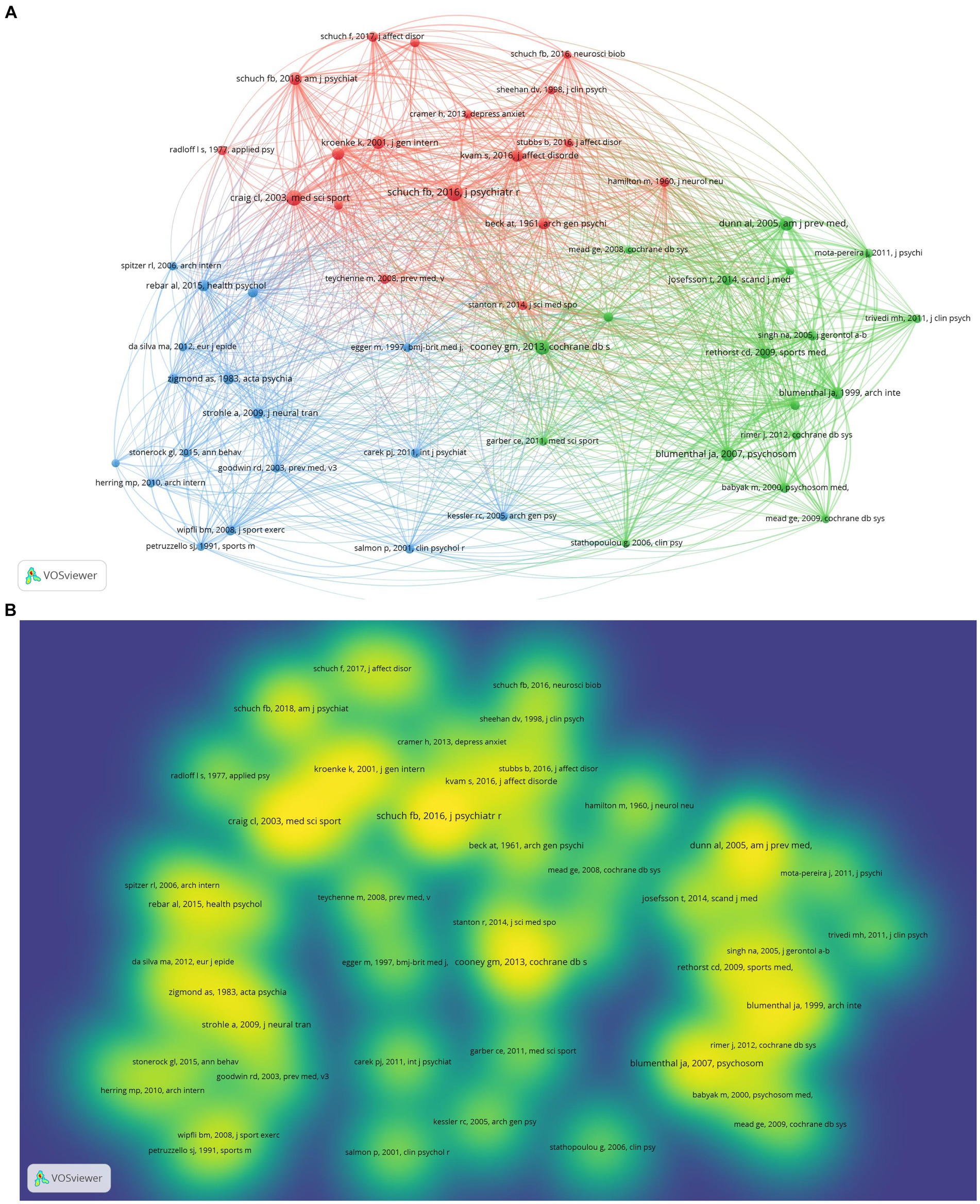
Figure 4. (A) The Cited references network visualization. (B) The Cited references density visualization.
Analysis of keywords
Furthermore, a visual map analysis of keywords was carried out using citespace (Figure 5A). As presented in Table 9, the top five keywords with the highest frequency were physical activity (652 times), symptoms (370 times), exercise (351 times), health (253 times), and Meta-analysis (245 times). In addition, the centrality, indicating the connectivity of nodes, of the following three keywords was greater than 0.5 and ranked amongst the top 3, namely physical activity (0.80), mental disorders (0.58), and risk (0.50). A higher centrality signifies a larger number of items connected through nodes, thereby reflecting the importance of nodes in the network. Generally, a centrality greater than 0.1 is regarded as significant.
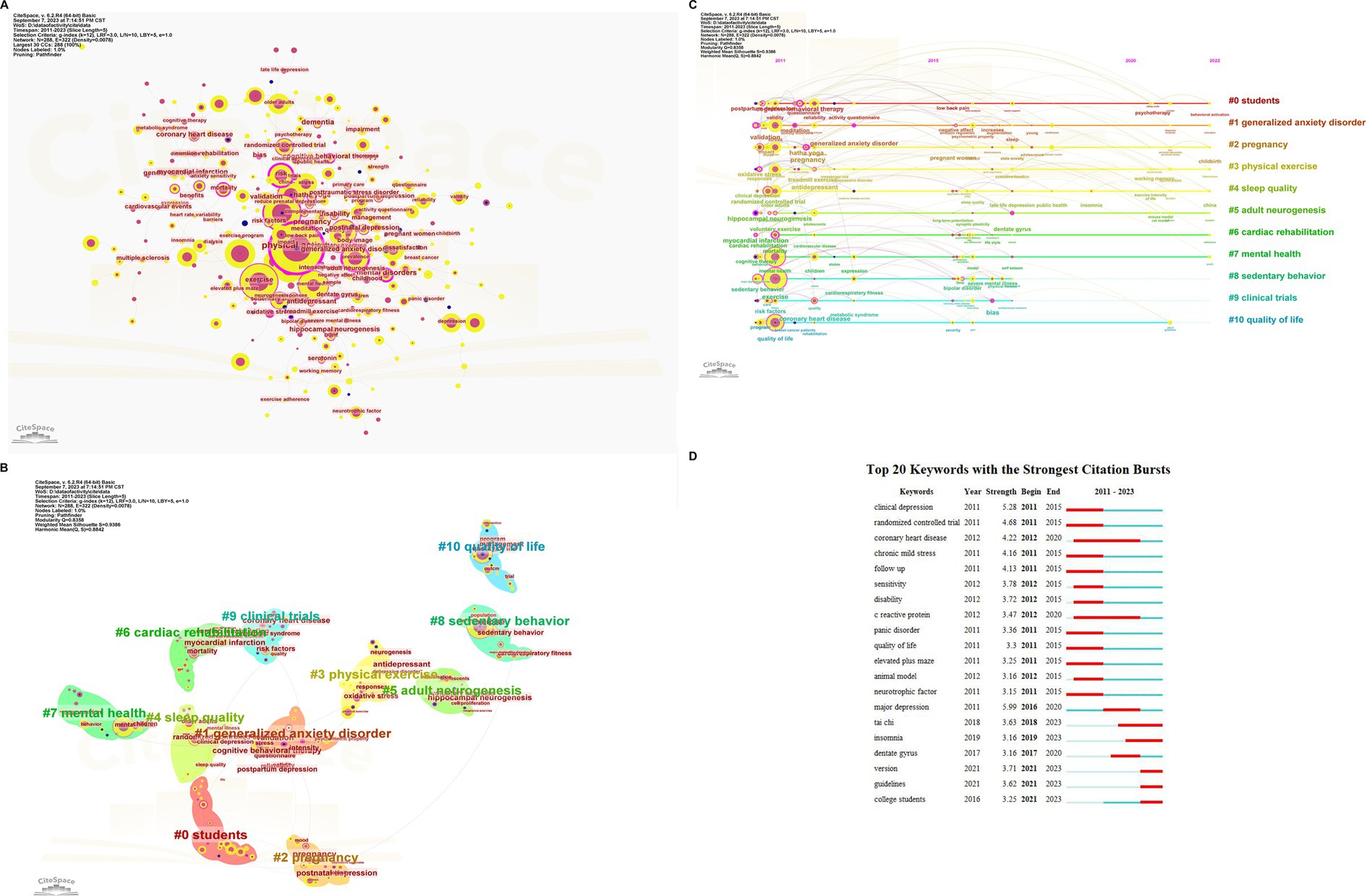
Figure 5. (A) Visualization of keywords. (B) Cluster analysis of keywoeds. (C) Timeline graph of cluster analysis. (D) Top 20 keywords with the most strongest bursts.
Based on the keyword map, keyword clustering (Figure 5B) was performed to identify the main research content in this field. Modularity Q and Mean Silhouette are the basis for evaluating the rationality of scientific map clustering. Usually, if the Q value is greater than 0.3, the clustering structure is significant. If the S value is greater than 0.7, the clustering is convincing. In this clustering knowledge graph, the Q and S values were 0.8358 and 0.9386, respectively, suggesting an acceptable clustering. The top 11 keyword clustering labels were selected for analysis (Table 10). # 0 students, # 2 pregnancy belongs to the research object. # 1 generalized anxiety disorder is a disease. # 3 physical exercise and # 8 sedentary behavior are distinct lifestyles. # 4 sleep quality, # 6 cardiac rehabilitation, # 7 mental health and # 10 quality of life involve different observation indexes. # 5 adult neurogenesis is a physiological and pathological mechanism. # 9 clinical trials are research types. The keyword timeline diagram (Figure 5C) highlights the research progress of keyword nodes in each cluster.
Burst keywords with strong strength (Figure 5D) can reveal the research frontiers and development trends in a research field. In this study, significant research hotspots in this field in recent years were version (burst strength 3.71), tai chi (burst strength 3.63), guidelines (burst strength 3.62), college students (burst strength 3.25), insomnia (burst strength 3.16), and dentate gyrus (burst strength 3.16). According to the results of the burst keywords, the current hotspot research appears to be tai chi, focusing on a group of students based on the exploration mechanism of the dentate gyrus in the hippocampus.
Discussion
Overall, the results of this study revealed the current status and trends in the field of PA on anxiety or depression. The research in this field has consistently expanded, demonstrating ongoing scholarly interest. Notably, the USA and Brazil have emerged as key countries in the field, with the latter depicting the closest and most central cooperation with other nations and the former conducting the highest number of research and the largest number of corresponding authors. Noteworthily, Harvard University remains a prolific contributor to this area of research. Among authors, Stubbs B was identified as the most prominent, with the highest number of published papers and H-index. A network of author cooperation centered on Stubbs B was also noted. Stanton R’s articles, published in 2020 (Stanton et al., 2020), garnered the highest total citations and were associated with the negative impact of Corona Virus Disease 2019 (COVID-19) on mental health in Australia. This finding may be ascribed to the particular attention paid by scholars on COVID-19-related articles. Among references considered in the final included studies, Schuch Fb’s article published in 2016 (Schuch et al., 2016) was the most frequently cited one. Their study determined that previous meta-analyses may underestimate the huge of exercise antidepressants due to publication bias.
According to the keyword frequency analysis (Table 9), meta-analysis (245 times) is a type of research that is of concern in this field. As the highest level of medical evidence, meta-analysis plays a fundamental role in clinical guidance. Josefsson et al. (2014) conducted a meta-analysis and demonstrated a significant overall effect of exercise intervention on depression. Thus, physical exercise is recommended for patients with depressive symptoms. At the same time, Zhang et al. (2023) conducted a network meta-analysis and found that resistance exercise 3–4 times a week for 30–60 min, lasting more than 6 weeks, exerted a substantial effect on the treatment and prevention of depression. Furthermore, Lin and Gao (2023) evaluated on the anxiety symptoms of college students and evinced the positive effect of PA on relieving anxiety, with aerobic exercise being potentially the optimal choice.
According to the keyword clustering map constructed from the research results, clusters #0 and #2 signaled that the field pays close attention to the anxiety and depression levels of students and pregnant women. With rapid economic expansion, the pressure faced by students is becoming increasingly heavy. However, most students grow up under the care and love of their families. As they enter the academic environment and confront the high pressure of learning and peer relationships, their mental health is affected (Slimmen et al., 2022). Therefore, it is vital to monitor students’ mental health and implement the necessary measures. Nonetheless, there are shortcomings in approving drug treatment regimens for young adults due to the unknown long-term risks on their future lives (You et al., 2021). At present, non-pharmacological interventions are preferred over drug therapy. Previous studies have concluded that low-intensity physical exercise can significantly enhance the mental health of college students, which can be attributed to the activation of potential targets in the brain (Zhu et al., 2020). Women experience physical and emotional fluctuations during pregnancy and childbirth. Pregnancy-related anxiety (PrA) is a special anxiety response characterized by fear and worry during pregnancy (Huizink et al., 2004), experienced by up to 14.4% (Poikkeus et al., 2006) of pregnant women. Additionally, postpartum depression is one of the most prevalent complications following childbirth. It comprises any depression women may experience from the beginning of their pregnancy until four weeks after delivery (Poyatos-León et al., 2017). According to a study undertaken by the U.S. Centers for Disease Control and Prevention (Bauman et al., 2020), approximately one in eight women develop postpartum depression. Hence, it is critical to timely identify pregnant and post-partum women with depression or anxiety disorders. Notwithstanding, it can have a devastating impact on mothers and children without timely intervention and, most importantly, exert a negative effect on mother-to-child relationships (Sanger et al., 2015). PA during pregnancy and postpartum is a viable strategy to achieve better mental health (Poyatos-León et al., 2017).
According to cluster #1, generalized anxiety disorder (GAD) is a prominent type of research disease in this field. With a global average lifetime prevalence of around 3.7% (Wittchen et al., 2002), GAD is among the most common types of anxiety disorders. Specifically, its prevalence is higher in women (Luo et al., 2019), who usually experience more severe symptoms of somatic anxiety (Steiner et al., 2005). A clinical study reported that exercise therapy is a feasible, safe, and well-tolerated treatment for GAD and could be a potential adjunctive therapy for sedentary women with GAD (Herring et al., 2012). According to cluster #8, this field focuses on sedentary behavior, which requires the least PA and leads to low energy consumption, similar to resting levels (Pate et al., 2009). It includes sitting for a series of purposes (such as work and travel) and screen-based activities, such as using computers, video games, and watching TV. Existing evidence suggests that sedentary behavior can increase the risk of cardiovascular disease (Katzmarzyk et al., 2009), osteoporosis (Warburton et al., 2006), and diabetes (Hu et al., 2003). Moreover, prior studies have established sedentary behavior as a risk factor for anxiety and depression (Huizink et al., 2004; Teychenne et al., 2010, 2015). In other words, sedentary behavior affects not only physical health but also mental health.
Cluster #5 Adult neurogenesis (AN), the ability to produce new neurons from neural stem cells to adulthood, persists in specific regions of the brain throughout the life cycle of mammals, especially in the subgranular zone of the hippocampal dentate gyrus (DG) and the subventricular zone of the lateral ventricle (Ming and Song, 2011; Gage, 2019). Based on existing research, exercise (Schoenfeld and Swanson, 2021) and study (Gould et al., 1999) can promote adult neurogenesis. Conversely, stress (Hueston et al., 2017), heredity (Jacobs, 2002), senescence (Olariu et al., 2007), and unhealthy diet (Poulose et al., 2017) can inhibit AN (Figure 6A). According to the burst keyword dentate gyrus, we have noticed adult hippocampal neurogenesis (AHN) (Terreros-Roncal et al., 2021), which refers to the process by which neural stem cells synthesize new neurons in the hippocampus. It is universally acknowledged as a fundamental brain function, supporting endogenous regeneration and facilitating structural plasticity that aids the brain in adapting to environmental stressors (Mahar et al., 2014). Moreover, AHN plays a crucial role in learning, memory, and emotion regulation (Hill et al., 2015). To date, sufficient experimental evidence supports its role in governing depression and anxiety (Lim et al., 2021). Luo et al. (2023) claimed that exercise can effectively alleviate mental disorders, including anxiety and depression, and its neural mechanism can be attributed to improvements in AN. Nonetheless, the mechanism underlying PA-induced AN has not been determined so far. However, these important effects of PA in AN seem to be mainly mediated by neurotrophic factors including brain-derived neurotrophic factor (BDNF), insulin-like growth factor 1 (IGF-1), and vascular endothelial growth factor (VEGF) (Cotman et al., 2007). Nevertheless, whether these neurotrophins are the causes or the consequences of PA-induced neurogenesis and the mechanisms by which they mediate PA-induced neurogenesis remain to be determined. BDNF may be a convergent target of PA-induced peripheral factors in the brain (Gao et al., 2023). To begin, numerous peripheral factors are released, among which BDNF shows the most significant increase in the brain. Moreover, BDNF is a positive regulator of mature AN (Liu and Nusslock, 2018). Peripheral BDNF can pass through blood–brain barrier (BBB) (Pan et al., 1998). Finality, PA can up-regulate the expression of cathepsin B in muscles and drive the accumulation of metabolite lactic acid, both of which can cross the BBB and enhance the expression levels of BDNF in the hippocampus (Moon et al., 2016; El Hayek et al., 2019). Furthermore, PA can induce structural and functional changes, including an increase in adult neurogenesis (van Praag et al., 1999), remodeling of dendritic structures (Eadie et al., 2005), and enhancement of synaptic plasticity in the hippocampus (van Praag et al., 1999), suggesting a biological basis for PA in protecting the brain against stress (Figure 6B). A prior study (Li et al., 2019) has suggested that PA may rescue impaired neuronal plasticity by regulating neurotrophic factors and adjusting the adaptive response of the hypothalamic–pituitary–adrenal axis to stress.
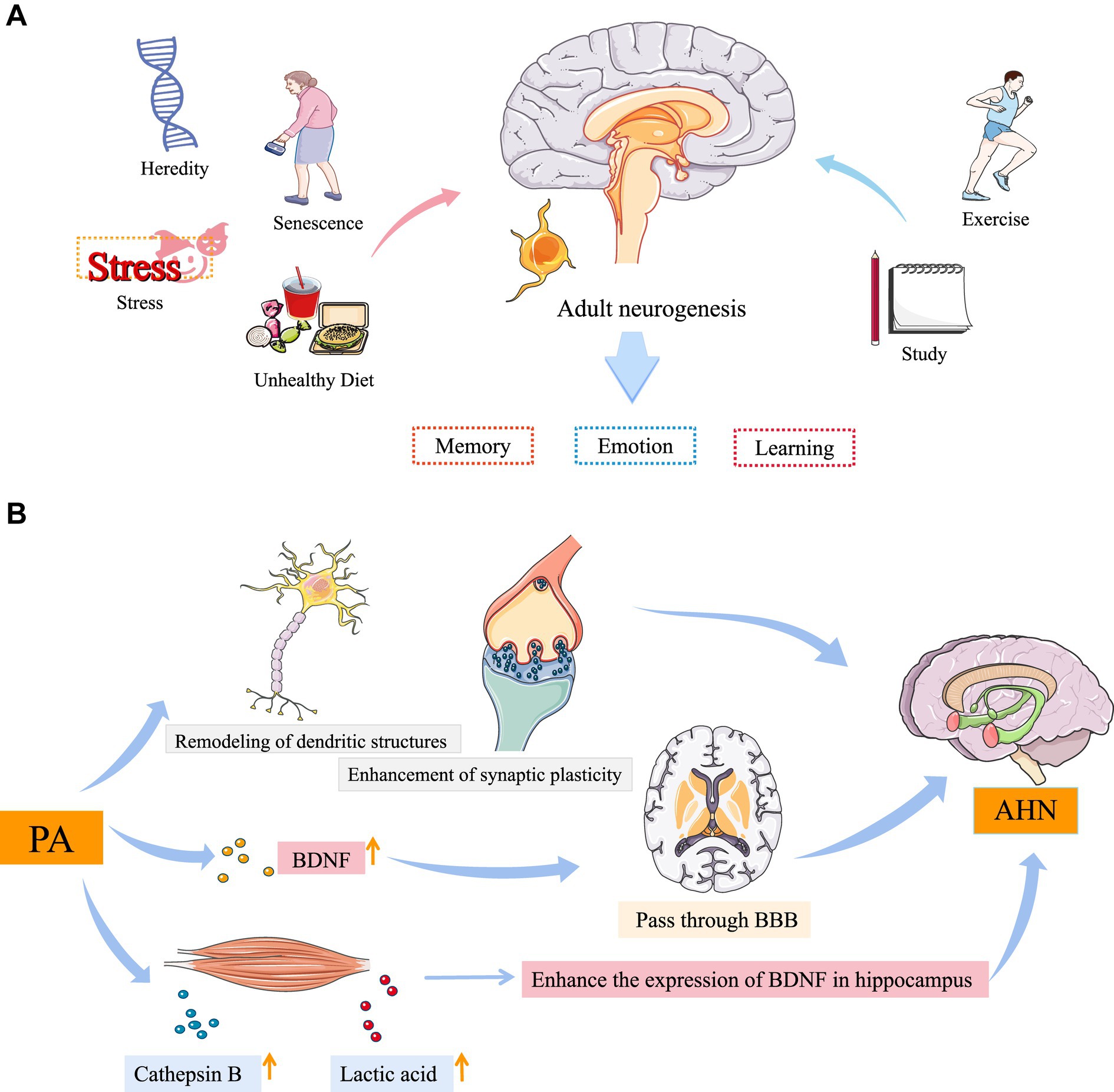
Figure 6. (A) Adult neurogenesis. (B) The possible mechanism underlying PA induced AHN. PA, physical activity; BNDF, brain-derived neurotrophic factor; BBB, blood–brain barrier; AHN, adult hippocampal neurogenesis. Images reproduced from Servier Medical Art (https://smart.servier.com/) under the terms of CC-BY 4.0.
According to the results of the burst keywords, recent studies focused on Tai Chi, a traditional Chinese sports that is currently classified as mind–body exercise (MBE, exercise aiming to improve participants’ mind–body coordination and awareness by having them practice a series of controlled movements that focus on interactions among the brain, body, mind, and behavior, such as Tai Chi, yoga, and dance, etc.) (Huang et al., 2022). It has been extensively applied for the prevention and treatment of various diseases, such as cancer (Song et al., 2020), knee osteoarthritis (Zhang et al., 2023), mild cognitive impairment (Zhang et al., 2019), and so on. It is worthwhile emphasizing that a meta-analysis has demonstrated that Tai Chi is more effective than non-mindfulness exercises in reducing anxiety and depression levels and improving general mental health (Yin et al., 2023). Moreover, Tai Chi possesses the advantage of minimal equipment requirements and is not limited by location or facilities.
According to the keywords, students and pregnant women were identified as groups of concern. Similarly, AN was established as a physiological and pathological mechanism of interest. Sedentary behavior was the lifestyle of concern, while GAD is the type of disease of concern. Finally, Tai Chi is the type of PA of interest.
Limitation
Reviewing previous studies, there are bibliometric analyses focusing on exercise and depression in teenagers (You et al., 2021) and college students nearly 20 years ago (Ai et al., 2023), as well as on the 50 most-cited articles (Zhai and Xu, 2023). This study did not impose restrictions on time and group. However, there are inherent limitations associated with this study that cannot be overlooked. Firstly, due to the shortcomings of the current bibliometric analysis software, it is challenging to analyze the data from multiple databases, and thus, this study exclusively screened articles from the WOSCC database. In addition, to mitigate the influence of confounding factors in the abstract, articles were searched by title, potentially introducing bias in the search strategy. Finally, our analysis solely included articles and reviews published in English and excluded abstracts, conferences, or books. Therefore, the results of the study may lack comprehensive coverage. On the other hand, while we analyzed the meta-analysis studies in cited literature and references, the extracted information did not provide valuable information on the impact of gender, age, population, and other factors on the results of the study, potentially impacting the discussion results cited in the review and meta-analysis.
Conclusion
In this study, the bibliometric analysis provided information regarding emerging trends about the field of PA on anxiety or depression. Although this work has some limitations, the results may be useful as a basis for helping patients with anxiety or depression and as a foundation for further research in this field. Based on our results, the field of PA on anxiety or depression demonstrating ongoing scholarly interest. Students and pregnant women, adult neurogenesis, and Tai Chi were the prominent keywords. For clinicians, they can consider to recommend patients to perform mind–body exercise for improving mood, especially for students and pregnant women who use medications with cautions. Additionally, future researchers can explore the mind–body exercise and its impact on anxiety or depression, PA and anxiety or depression in specific populations, and adult neurogenesis of various exercise in anxiety or depression.
Data availability statement
The original contributions presented in the study are included in the article, further inquiries can be directed to the corresponding author.
Author contributions
X-YZ: Writing – original draft. FY: Supervision, Writing – review & editing. Z-HY: Supervision, Writing – review & editing. Y-QL: Data curation, Writing – original draft. Q-NB: Data curation, Writing – original draft. M-ZX: Investigation, Writing – original draft. Z-HC: Visualization, Writing – original draft. W-QZ: Visualization, Writing – original draft. K-XW: Investigation, Writing – original draft. JY: Investigation, Writing – original draft. F-RL: Writing – review & editing.
Funding
The author(s) declare financial support was received for the research, authorship, and/or publication of this article. This work was supported by the National Natural Science Foundation of China (grant numbers: 81590950), and Chengdu University of Traditional Chinese Medicine.
Acknowledgments
We really appreciate for the founding team of CiteSpace, VOSviewer and Bibliometrix Packages for free use of these software. At the same time, we also thank https://smart.servier.com/ for providing free drawing materials.
Conflict of interest
The authors declare that the research was conducted in the absence of any commercial or financial relationships that could be construed as a potential conflict of interest.
Publisher’s note
All claims expressed in this article are solely those of the authors and do not necessarily represent those of their affiliated organizations, or those of the publisher, the editors and the reviewers. Any product that may be evaluated in this article, or claim that may be made by its manufacturer, is not guaranteed or endorsed by the publisher.
Supplementary material
The Supplementary material for this article can be found online at: https://www.frontiersin.org/articles/10.3389/fnins.2024.1337739/full#supplementary-material
References
Ai, Z., Yuan, D., Meng, Y., Ai, Z., and Zhu, S. (2023). Research trends of exercise therapy of college students in depression from 2002 to 2022: a bibliometric analysis. Front. Neurosci. 17:1188341. doi: 10.3389/fnins.2023.1188341
Ali, M. J. (2021). Understanding the 'g-index' and the 'e-index'. Semin. Ophthalmol. 36:139. doi: 10.1080/08820538.2021.1922975
Bauman, B. L., Ko, J. Y., Cox, S., D’Angelo, MPH, D. V., Warner, L., Folger, S., et al. (2020). Vital signs: postpartum depressive symptoms and provider discussions about perinatal depression - United States, 2018. MMWR Morb. Mortal Wkly. Rep. 69, 575–581. doi: 10.15585/mmwr.mm6919a2
Baxter, A. J., Scott, K. M., Vos, T., and Whiteford, H. A. (2013). Global prevalence of anxiety disorders: a systematic review and meta-regression. Psychol. Med. 43, 897–910. doi: 10.1017/S003329171200147X
Beesdo-Baum, K., and Knappe, S. (2012). Developmental epidemiology of anxiety disorders. Child Adolesc. Psychiatr. Clin. N. Am. 21, 457–478. doi: 10.1016/j.chc.2012.05.001
Blumenthal, J. A., Babyak, M. A., Doraiswamy, P. M., Watkins, L., Hoffman, B. M., Barbour, K. A., et al. (2007). Exercise and pharmacotherapy in the treatment of major depressive disorder. Psychosom. Med. 69, 587–596. doi: 10.1097/PSY.0b013e318148c19a
Carvalho, A. F., Sharma, M. S., Brunoni, A. R., Vieta, E., and Fava, G. A. (2016). The safety, tolerability and risks associated with the use of newer generation antidepressant drugs: a critical review of the literature. Psychother. Psychosom. 85, 270–288. doi: 10.1159/000447034
Caspersen, C. J., Powell, K. E., and Christenson, G. M. (1985). Physical activity, exercise, and physical fitness: definitions and distinctions for health-related research. Public Health Rep. 100, 126–131.
Chen, C., Hu, Z., Liu, S., and Tseng, H. (2012). Emerging trends in regenerative medicine: a scientometric analysis in CiteSpace. Expert. Opin. Biol. Ther. 12, 593–608. doi: 10.1517/14712598.2012.674507
Chen, C., and Song, M. (2019). Visualizing a field of research: a methodology of systematic scientometric reviews. PLoS One 14:e223994. doi: 10.1371/journal.pone.0223994
Clayton, A. H., Pradko, J. F., Croft, H. A., Montano, C. B., Leadbetter, R. A., Bolden-Watson, C., et al. (2002). Prevalence of sexual dysfunction among newer antidepressants. J. Clin. Psychiatry 63, 357–366. doi: 10.4088/JCP.v63n0414
Cooney, G. M., Dwan, K., Greig, C. A., Lawlor, D. A., Rimer, J., Waugh, F. R., et al. (2013). Exercise for depression. Cochrane Database Syst. Rev. 2013:CD4366. doi: 10.1002/14651858.CD004366.pub6
Cotman, C. W., Berchtold, N. C., and Christie, L. A. (2007). Exercise builds brain health: key roles of growth factor cascades and inflammation. Trends Neurosci. 30, 464–472. doi: 10.1016/j.tins.2007.06.011
Cui, L., Tang, W., Deng, X., and Jiang, B. (2023). Farm animal welfare is a field of interest in China: a bibliometric analysis based on CiteSpace. Animals 13:3143. doi: 10.3390/ani13193143
Dong, Q., Liang, Q., Chen, Y., Li, J., Lu, L., Huang, X., et al. (2021). Bibliometric and visual analysis of vascular calcification research. Front. Pharmacol. 12:690392. doi: 10.3389/fphar.2021.690392
Dunn, A. L., Trivedi, M. H., Kampert, J. B., Clark, C. G., and Chambliss, H. O. (2005). Exercise treatment for depression: efficacy and dose response. Am. J. Prev. Med. 28, 1–8. doi: 10.1016/j.amepre.2004.09.003
Eadie, B. D., Redila, V. A., and Christie, B. R. (2005). Voluntary exercise alters the cytoarchitecture of the adult dentate gyrus by increasing cellular proliferation, dendritic complexity, and spine density. J. Comp. Neurol. 486, 39–47. doi: 10.1002/cne.20493
El Hayek, L., Khalifeh, M., Zibara, V., Abi Assaad, R., Emmanuel, N., Karnib, N., et al. (2019). Lactate mediates the effects of exercise on learning and memory through SIRT1-dependent activation of hippocampal brain-derived neurotrophic factor (BDNF)[J]. J. Neurosci. 39, 2369–2382. doi: 10.1523/JNEUROSCI.1661-18.2019
Fischer, A. S., Camacho, M. C., Ho, T. C., Whitfield-Gabrieli, S., and Gotlib, I. H. (2018). Neural markers of resilience in adolescent females at familial risk for major depressive disorder. JAMA Psychiatry 75, 493–502. doi: 10.1001/jamapsychiatry.2017.4516
Gage, F. H. (2019). Adult neurogenesis in mammals. Science 364, 827–828. doi: 10.1126/science.aav6885
Gao, Y., Syed, M., and Zhao, X. (2023). Mechanisms underlying the effect of voluntary running on adult hippocampal neurogenesis. Hippocampus 33, 373–390. doi: 10.1002/hipo.23520
Gould, E., Beylin, A., Tanapat, P., Reeves, A., and Shors, T. J. (1999). Learning enhances adult neurogenesis in the hippocampal formation. Nat. Neurosci. 2, 260–265. doi: 10.1038/6365
Guilloux, J. P., David, D. J., Xia, L., Nguyen, H. T., Rainer, Q., Guiard, B. P., et al. (2011). Characterization of 5-HT(1A/1B)−/− mice: an animal model sensitive to anxiolytic treatments. Neuropharmacology 61, 478–488. doi: 10.1016/j.neuropharm.2011.02.009
Hao, Z., Liu, K., Qi, W., Zhang, X., Zhou, L., and Chen, P. (2023). Which exercise interventions are more helpful in treating primary obesity in young adults? A systematic review and Bayesian network meta-analysis. Arch. Med. Sci. 19, 865–883. doi: 10.5114/aoms/153479
Harvey, A. T., Rudolph, R. L., and Preskorn, S. H. (2000). Evidence of the dual mechanisms of action of venlafaxine. Arch. Gen. Psychiatry 57, 503–509. doi: 10.1001/archpsyc.57.5.503
Herring, M. P., Jacob, M. L., Suveg, C., Dishman, R. K., and O’Connor, P. J. (2012). Feasibility of exercise training for the short-term treatment of generalized anxiety disorder: a randomized controlled trial. Psychother. Psychosom. 81, 21–28. doi: 10.1159/000327898
Hill, A. S., Sahay, A., and Hen, R. (2015). Increasing adult hippocampal neurogenesis is sufficient to reduce Anxiety and depression-like behaviors. Neuropsychopharmacology 40, 2368–2378. doi: 10.1038/npp.2015.85
Hirsch, J. E. (2005). An index to quantify an individual's scientific research output. Proc. Natl. Acad. Sci. USA 102, 16569–16572. doi: 10.1073/pnas.0507655102
Hirsch, J. E. (2007). Does the h index have predictive power? Proc. Natl. Acad. Sci. 104, 19193–19198. doi: 10.1073/pnas.0707962104
Hu, F. B., Li, T. Y., Colditz, G. A., Willett, W. C., and Manson, J. A. E. (2003). Television watching and other sedentary behaviors in relation to risk of obesity and type 2 diabetes mellitus in women. JAMA 289, 1785–1791. doi: 10.1001/jama.289.14.1785
Huang, X., Zhao, X., Li, B., Cai, Y., Zhang, S., Wan, Q., et al. (2022). Comparative efficacy of various exercise interventions on cognitive function in patients with mild cognitive impairment or dementia: a systematic review and network meta-analysis. J. Sport Health Sci. 11, 212–223. doi: 10.1016/j.jshs.2021.05.003
Hueston, C. M., Cryan, J. F., and Nolan, Y. M. (2017). Stress and adolescent hippocampal neurogenesis: diet and exercise as cognitive modulators. Transl. Psychiatry 7:e1081. doi: 10.1038/tp.2017.48
Huizink, A. C., Mulder, E. J., Robles de Medina, P. G., Visser, G. H. A., and Buitelaar, J. K. (2004). Is pregnancy anxiety a distinctive syndrome? Early Hum. Dev. 79, 81–91. doi: 10.1016/j.earlhumdev.2004.04.014
Jacobs, B. L. (2002). Adult brain neurogenesis and depression. Brain Behav. Immun. 16, 602–609. doi: 10.1016/S0889-1591(02)00015-6
Ji, B., Yang, G., Jin, H., Liu, X., Li, H., Pan, L., et al. (2023). Trends and hotspots of publications on ferroptosis: a 10 year overview. Heliyon 9:e18950. doi: 10.1016/j.heliyon.2023.e18950
Josefsson, T., Lindwall, M., and Archer, T. (2014). Physical exercise intervention in depressive disorders: meta-analysis and systematic review. Scand. J. Med. Sci. Sports 24, 259–272. doi: 10.1111/sms.12050
Katzmarzyk, P. T., Church, T. S., Craig, C. L., and Bouchard, C. (2009). Sitting time and mortality from all causes, cardiovascular disease, and cancer. Med. Sci. Sports Exerc. 41, 998–1005. doi: 10.1249/MSS.0b013e3181930355
Kazeminasab, F., Sharafifard, F., Miraghajani, M., Behzadnejad, N., and Rosenkranz, S. K. (2023). The effects of exercise training on insulin resistance in children and adolescents with overweight or obesity: a systematic review and meta-analysis. Front. Endocrinol. 14:1178376. doi: 10.3389/fendo.2023.1178376
Krogh, J., Nordentoft, M., Sterne, J. A., and Lawlor, D. A. (2011). The effect of exercise in clinically depressed adults: systematic review and meta-analysis of randomized controlled trials. J. Clin. Psychiatry 72, 529–538. doi: 10.4088/JCP.08r04913blu
Kvam, S., Kleppe, C. L., Nordhus, I. H., and Hovland, A. (2016). Exercise as a treatment for depression: a meta-analysis. J. Affect. Disord. 202, 67–86. doi: 10.1016/j.jad.2016.03.063
Li, A., Yau, S. Y., Machado, S., Wang, P., Yuan, T. F., and So, K. F. (2019). Enhancement of hippocampal plasticity by physical exercise as a Polypill for stress and depression: a review. CNS Neurol. Disord. Drug Targets 18, 294–306. doi: 10.2174/1871527318666190308102804
Lim, J., Kim, H. I., Bang, Y., and Choi, H. J. (2021). Peroxisome proliferator-activated receptor gamma: a novel therapeutic target for cognitive impairment and mood disorders that functions via the regulation of adult neurogenesis. Arch. Pharm. Res. 44, 553–563. doi: 10.1007/s12272-021-01333-7
Lin, Y., and Gao, W. (2023). The effects of physical exercise on anxiety symptoms of college students: a meta-analysis. Front. Psychol. 14:1136900. doi: 10.3389/fpsyg.2023.1136900
Liu, P. Z., and Nusslock, R. (2018). Exercise-mediated neurogenesis in the Hippocampus via BDNF. Front. Neurosci. 12:52. doi: 10.3389/fnins.2018.00052
Luo, Z., Chen, J., Dai, Y., So, K. F., and Zhang, L. (2023). Treadmill exercise modulates the medial prefrontal-amygdala neural circuit to improve the resilience against chronic restraint stress. Commun. Biol. 6:624. doi: 10.1038/s42003-023-05003-w
Luo, Z., Li, Y., Hou, Y., Liu, X., Jiang, J., Wang, Y., et al. (2019). Gender-specific prevalence and associated factors of major depressive disorder and generalized anxiety disorder in a Chinese rural population: the Henan rural cohort study. BMC Public Health 19:1744. doi: 10.1186/s12889-019-8086-1
Madonna, D., Delvecchio, G., Soares, J. C., and Brambilla, P. (2019). Structural and functional neuroimaging studies in generalized anxiety disorder: a systematic review. Braz. J. Psychiatry 41, 336–362. doi: 10.1590/1516-4446-2018-0108
Mahar, I., Bambico, F. R., Mechawar, N., and Nobrega, J. N. (2014). Stress, serotonin, and hippocampal neurogenesis in relation to depression and antidepressant effects. Neurosci. Biobehav. Rev. 38, 173–192. doi: 10.1016/j.neubiorev.2013.11.009
Malhi, G. S., and Mann, J. J. (2018). Depression. Lancet 392, 2299–2312. doi: 10.1016/S0140-6736(18)31948-2
Mammen, G., and Faulkner, G. (2013). Physical activity and the prevention of depression: a systematic review of prospective studies. Am. J. Prev. Med. 45, 649–657. doi: 10.1016/j.amepre.2013.08.001
McCarron, R. M., Shapiro, B., Rawles, J., and Luo, J. (2021). Depression. Ann. Intern. Med. 174:ITC65-ITC80. doi: 10.7326/AITC202105180
Mendlowicz, M. V., Gekker, M., Xavier Gomes de Araújo, A., de Oliveira, L., Pereira, M. G., Berger, W., et al. (2022). The top-100 cited articles on post-traumatic stress disorder: a historical bibliometric analysis. Psychol. Health Med. 29, 1–20. doi: 10.1080/13548506.2022.2147555
Ming, G. L., and Song, H. (2011). Adult neurogenesis in the mammalian brain: significant answers and significant questions. Neuron 70, 687–702. doi: 10.1016/j.neuron.2011.05.001
Moon, H. Y., Becke, A., Berron, D., Becker, B., Sah, N., Benoni, G., et al. (2016). Running-induced systemic Cathepsin B secretion is associated with memory function. Cell Metab. 24, 332–340. doi: 10.1016/j.cmet.2016.05.025
Noone, C., Dwyer, C. P., Murphy, J., Newell, J., and Molloy, G. J. (2018). Comparative effectiveness of physical activity interventions and anti-hypertensive pharmacological interventions in reducing blood pressure in people with hypertension: protocol for a systematic review and network meta-analysis. Syst. Rev. 7:128. doi: 10.1186/s13643-018-0791-9
Offidani, E., Guidi, J., Tomba, E., and Fava, G. A. (2013). Efficacy and tolerability of benzodiazepines versus antidepressants in anxiety disorders: a systematic review and meta-analysis. Psychother. Psychosom. 82, 355–362. doi: 10.1159/000353198
Olariu, A., Cleaver, K. M., and Cameron, H. A. (2007). Decreased neurogenesis in aged rats results from loss of granule cell precursors without lengthening of the cell cycle. J. Comp. Neurol. 501, 659–667. doi: 10.1002/cne.21268
Page, M. J., McKenzie, J. E., Bossuyt, P. M., Boutron, I., Hoffmann, T. C., Mulrow, C. D., et al. (2021). The PRISMA 2020 statement: an updated guideline for reporting systematic reviews. BMJ 372:n71. doi: 10.1136/bmj.n71
Pan, W., Banks, W. A., Fasold, M. B., Bluth, J., and Kastin, A. J. (1998). Transport of brain-derived neurotrophic factor across the blood-brain barrier. Neuropharmacology 37, 1553–1561. doi: 10.1016/S0028-3908(98)00141-5
Pate, R. R. (2019). The report of the US physical Activity guidelines advisory committee: important findings for employers. Am. J. Health Promot. 33, 313–314. doi: 10.1177/0890117118816750b
Pate, R. R., Stevens, J., Webber, L. S., Dowda, M., Murray, D. M., Young, D. R., et al. (2009). Age-related change in physical activity in adolescent girls. J. Adolesc. Health 44, 275–282. doi: 10.1016/j.jadohealth.2008.07.003
Poikkeus, P., Saisto, T., Unkila-Kallio, L., Punamaki, R. L., Repokari, L., Vilska, S., et al. (2006). Fear of childbirth and pregnancy-related anxiety in women conceiving with assisted reproduction. Obstet. Gynecol. 108, 70–76. doi: 10.1097/01.AOG.0000222902.37120.2f
Poulose, S. M., Miller, M. G., Scott, T., and Shukitt-Hale, B. (2017). Nutritional factors affecting adult neurogenesis and cognitive function. Adv. Nutr. 8, 804–811. doi: 10.3945/an.117.016261
Poyatos-León, R., García-Hermoso, A., Sanabria-Martínez, G., Álvarez-Bueno, C., Cavero-Redondo, I., and Martínez-Vizcaíno, V. (2017). Effects of exercise-based interventions on postpartum depression: a meta-analysis of randomized controlled trials. Birth 44, 200–208. doi: 10.1111/birt.12294
Rebar, A. L., Stanton, R., Geard, D., Short, C., Duncan, M. J., and Vandelanotte, C. (2015). A meta-meta-analysis of the effect of physical activity on depression and anxiety in non-clinical adult populations. Health Psychol. Rev. 9, 366–378. doi: 10.1080/17437199.2015.1022901
Rethorst, C. D., Wipfli, B. M., and Landers, D. M. (2009). The antidepressive effects of exercise: a meta-analysis of randomized trials. Sports Med. 39, 491–511. doi: 10.2165/00007256-200939060-00004
Rezaei, S., Gharepapagh, E., Rashidi, F., Cattarinussi, G., Sanjari Moghaddam, H., di Camillo, F., et al. (2023). Machine learning applied to functional magnetic resonance imaging in anxiety disorders. J. Affect. Disord. 342, 54–62. doi: 10.1016/j.jad.2023.09.006
Sanger, C., Iles, J. E., Andrew, C. S., and Ramchandani, P. G. (2015). Associations between postnatal maternal depression and psychological outcomes in adolescent offspring: a systematic review. Arch. Womens Ment. Health 18, 147–162. doi: 10.1007/s00737-014-0463-2
Santomauro, D. F., Herrera, A. M. M., Shadid, J., Zheng, P., Ashbaugh, C., Pigott, D. M., et al. (2021). Global prevalence and burden of depressive and anxiety disorders in 204 countries and territories in 2020 due to the COVID-19 pandemic. Lancet 398, 1700–1712. doi: 10.1016/S0140-6736(21)02143-7
Schoenfeld, T. J., and Swanson, C. (2021). A Runner's high for new neurons? Potential role for endorphins in exercise effects on adult neurogenesis. Biomol. Ther. 11:1077. doi: 10.3390/biom11081077
Schuch, F. B., Vancampfort, D., Firth, J., Rosenbaum, S., Ward, P. B., Silva, E. S., et al. (2018). Physical Activity and incident depression: a Meta-analysis of prospective cohort studies. Am. J. Psychiatry 175, 631–648. doi: 10.1176/appi.ajp.2018.17111194
Schuch, F. B., Vancampfort, D., Richards, J., Rosenbaum, S., Ward, P. B., and Stubbs, B. (2016). Exercise as a treatment for depression: a meta-analysis adjusting for publication bias. J. Psychiatr. Res. 77, 42–51. doi: 10.1016/j.jpsychires.2016.02.023
Singh, B., Olds, T., Curtis, R., Dumuid, D., Virgara, R., Watson, A., et al. (2023). Effectiveness of physical activity interventions for improving depression, anxiety and distress: an overview of systematic reviews. Br. J. Sports Med. 57, 1203–1209. doi: 10.1136/bjsports-2022-106195
Slavich, G. M., and Irwin, M. R. (2014). From stress to inflammation and major depressive disorder: a social signal transduction theory of depression. Psychol. Bull. 140, 774–815. doi: 10.1037/a0035302
Slimmen, S., Timmermans, O., Mikolajczak-Degrauwe, K., and Oenema, A. (2022). How stress-related factors affect mental wellbeing of university students a cross-sectional study to explore the associations between stressors, perceived stress, and mental wellbeing. PLoS One 17:e275925. doi: 10.1371/journal.pone.0275925
Song, Y., Sun, D., István, B., Thirupathi, A., Liang, M., Teo, E. C., et al. (2020). Current evidence on traditional Chinese exercise for cancers: a systematic review of randomized controlled trials. Int. J. Environ. Res. Public Health 17:5011. doi: 10.3390/ijerph17145011
Stanton, R., To, Q. G., Khalesi, S., Williams, S. L., Alley, S. J., Thwaite, T. L., et al. (2020). Depression, Anxiety and stress during COVID-19: associations with changes in physical Activity, sleep, tobacco and alcohol use in Australian adults. Int. J. Environ. Res. Public Health 17:4065. doi: 10.3390/ijerph17114065
Steiner, M., Allgulander, C., Ravindran, A., Kosar, H., Burt, T., and Austin, C. (2005). Gender differences in clinical presentation and response to sertraline treatment of generalized anxiety disorder. Hum. Psychopharmacol. 20, 3–13. doi: 10.1002/hup.648
Terreros-Roncal, J., Moreno-Jiménez, E. P., Flor-García, M., Rodríguez-Moreno, C. B., Trinchero, M. F., Cafini, F., et al. (2021). Impact of neurodegenerative diseases on human adult hippocampal neurogenesis. Science 374, 1106–1113. doi: 10.1126/science.abl5163
Teychenne, M., Ball, K., and Salmon, J. (2010). Sedentary behavior and depression among adults: a review. Int. J. Behav. Med. 17, 246–254. doi: 10.1007/s12529-010-9075-z
Teychenne, M., Costigan, S. A., and Parker, K. (2015). The association between sedentary behaviour and risk of anxiety: a systematic review. BMC Public Health 15:513. doi: 10.1186/s12889-015-1843-x
Valenzuela, P. L., Ruilope, L. M., Santos-Lozano, A., Wilhelm, M., Kränkel, N., Fiuza-Luces, C., et al. (2023). Exercise benefits in cardiovascular diseases: from mechanisms to clinical implementation. Eur. Heart J. 44, 1874–1889. doi: 10.1093/eurheartj/ehad170
van Eck, N. J., and Waltman, L. (2010). Software survey: VOSviewer, a computer program for bibliometric mapping. Scientometrics 84, 523–538. doi: 10.1007/s11192-009-0146-3
van Praag, H., Christie, B. R., Sejnowski, T. J., and Gage, F. H. (1999). Running enhances neurogenesis, learning, and long-term potentiation in mice. Proc. Natl. Acad. Sci. USA 96, 13427–13431. doi: 10.1073/pnas.96.23.13427
van Praag, H., Kempermann, G., and Gage, F. H. (1999). Running increases cell proliferation and neurogenesis in the adult mouse dentate gyrus. Nat. Neurosci. 2, 266–270. doi: 10.1038/6368
Vancampfort, D., Firth, J., Schuch, F. B., Rosenbaum, S., Mugisha, J., Hallgren, M., et al. (2017). Sedentary behavior and physical activity levels in people with schizophrenia, bipolar disorder and major depressive disorder: a global systematic review and meta-analysis. World Psychiatry 16, 308–315. doi: 10.1002/wps.20458
Warburton, D. E., Nicol, C. W., and Bredin, S. S. (2006). Health benefits of physical activity: the evidence. CMAJ 174, 801–809. doi: 10.1503/cmaj.051351
Wittchen, H. U., Kessler, R. C., Beesdo, K., Krause, P., and Hoyer, J. (2002). Generalized anxiety and depression in primary care: prevalence, recognition, and management. J. Clin. Psychiatry 63, 24–34.
Xiong, H. Y., Liu, H., and Wang, X. Q. (2021). Top 100 Most-cited papers in neuropathic pain from 2000 to 2020: a bibliometric study. Front. Neurol. 12:765193. doi: 10.3389/fneur.2021.765193
Yang, G., Xie, W., Ding, Y., Wang, W., Huang, C., Zhao, T., et al. (2022). A worldwide bibliometric analysis of Tetrandrine research in recent two decades. Front. Pharmacol. 13:896050. doi: 10.3389/fphar.2022.896050
Yin, J., Yue, C., Song, Z., Sun, X., and Wen, X. (2023). The comparative effects of tai chi versus non-mindful exercise on measures of anxiety, depression and general mental health: a systematic review and meta-analysis. J. Affect. Disord. 337, 202–214. doi: 10.1016/j.jad.2023.05.037
You, Y., Wang, D., Wang, Y., Li, Z., and Ma, X. (2021). A Bird's-eye view of exercise intervention in treating depression among teenagers in the last 20 years: a bibliometric study and visualization analysis. Front. Psych. 12:661108. doi: 10.3389/fpsyt.2021.661108
Zhai, L., and Xu, M. (2023). The 50 most-cited review papers on physical activity and depression: a bibliometric analysis. Complement. Ther. Clin. Pract. 51:101745. doi: 10.1016/j.ctcp.2023.101745
Zhang, N., Cui, H., Li, H., Yang, Y., Gao, Z., Zeng, X., et al. (2023). Effects of tai chi in knee osteoarthritis patients: an overview of systematic reviews and meta-analyses. Complement. Ther. Med. 77:102978. doi: 10.1016/j.ctim.2023.102978
Zhang, Q., Hu, J., Wei, L., Cao, R., Ma, R., Song, H., et al. (2019). Effects of traditional Chinese exercise on cognitive and psychological outcomes in older adults with mild cognitive impairment: a systematic review and meta-analysis. Medicine (Baltimore) 98:e14581. doi: 10.1097/MD.0000000000014581
Zhang, Y., Li, G., Liu, C., Guan, J., Zhang, Y., and Shi, Z. (2023). Comparing the efficacy of different types of exercise for the treatment and prevention of depression in youths: a systematic review and network meta-analysis. Front. Psych. 14:1199510. doi: 10.3389/fpsyt.2023.1199510
Zhu, J., Liang, Q., He, S., Wang, C., Lin, X., Wu, D., et al. (2022). Research trends and hotspots of neurodegenerative diseases employing network pharmacology: a bibliometric analysis. Front. Pharmacol. 13:1109400. doi: 10.3389/fphar.2022.1109400
Keywords: physical activity, depression, anxiety, bibliometric analysis, adult neurogenesis
Citation: Zhang X-Y, Ye F, Yin Z-H, Li Y-Q, Bao Q-N, Xia M-Z, Chen Z-H, Zhong W-Q, Wu K-X, Yao J and Liang F-R (2024) Research status and trends of physical activity on depression or anxiety: a bibliometric analysis. Front. Neurosci. 18:1337739. doi: 10.3389/fnins.2024.1337739
Edited by:
Stefano Farioli Vecchioli, National Research Council (CNR), ItalyReviewed by:
Daria E. A. Jensen, University Hospital Leipzig, GermanyCarla Masala, University of Cagliari, Italy
Copyright © 2024 Zhang, Ye, Yin, Li, Bao, Xia, Chen, Zhong, Wu, Yao and Liang. This is an open-access article distributed under the terms of the Creative Commons Attribution License (CC BY). The use, distribution or reproduction in other forums is permitted, provided the original author(s) and the copyright owner(s) are credited and that the original publication in this journal is cited, in accordance with accepted academic practice. No use, distribution or reproduction is permitted which does not comply with these terms.
*Correspondence: Fan-Rong Liang, acuresearch@126.com
†These authors have contributed equally to this work and share first authorship
 Xin-Yue Zhang
Xin-Yue Zhang Fang Ye3†
Fang Ye3† Zi-Han Yin
Zi-Han Yin Ya-Qin Li
Ya-Qin Li Ke-Xin Wu
Ke-Xin Wu Fan-Rong Liang
Fan-Rong Liang